‘A Simple Herstory’: Podcast creators remember past women on the presidential ballot
Surprisingly few people are aware that women other than Nikki Haley and Hillary Clinton have run for President of the United States.
Jocelyn Kuritsky SC ’04, Jonathan Goldberg and Jennifer Hall came to Scripps College’s Balch Auditorium on March 21 to set the record straight.
In the podcast “A Simple Herstory,” co-produced by Kurtisky, Goldberg and Hall, listeners are treated with not just audio, but scripted performances recounting the stories of several of the hundreds of women who have tried and failed to get their name on the ballot.
This event was hosted by Scripps Presents, a programming series showcasing different authors, celebrities, artists and activists. Kuritsky, Goldberg and Hall played snippets of their podcast in between discussions surrounding their historical retellings and motivations.
Lizzie Aguirre, a production manager at Scripps, spoke about the significance of platforming Kuritsky as an alum.
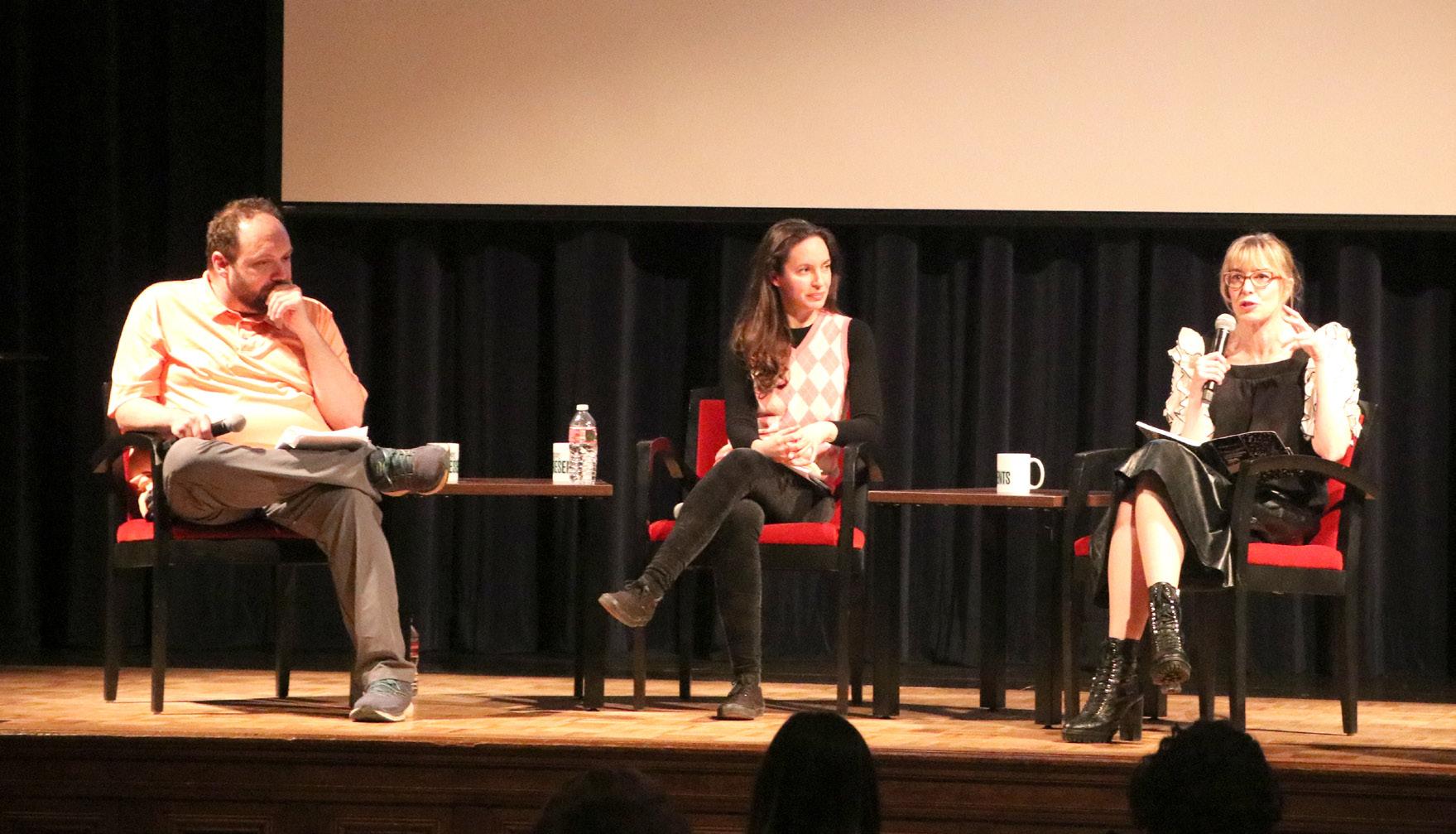
“[It’s] always important bringing back alums, lifting them up, showcasing their work and what they’ve gone on and grown to
Pitzer Green Bike Program launches new women and gender-nonconforming hours
ANNABELLE INK
On Feb. 27, the Pitzer Green Bike Program (GBP) began hosting weekly women and gender-nonconforming hours on Tuesdays from 3 to 5 p.m. The initiative, which allows students of all gender identities to stop by and receive support specifically from women and gender-nonconforming mechanics, was launched in an attempt to build a more inclusive environment and bolster diverse student engagement with the program.
The GBP was first started by students in 2001, when students founded it in the hopes of increasing bike usage on campus.
According to its webpage, “The GBP began as an attempt to counter Los Angeles’ renowned car culture by encouraging people to use bikes and by facilitating their accessibility for Pitzer students and their maintenance for the whole of The Claremont College Consortium.”
The program, which is based in a small work shed across from Skandera Hall, offers free mechanical support to all students and faculty members across the 5Cs — the only cost is that of new bike parts. The GBP also provides a 24-hour bike rental service for Pitzer students, as well as bike raffles held at the start of each semester with refurbished bikes found abandoned around campus.
According to Annika Salomonsson PZ ’25, a staff member at the GBP, the new women and gender-nonconforming hours were created largely in response to student anxieties
about the GBP’s ‘intimidating’ environment. “There’s usually a big group of people hanging out outside and if you don’t know any of them, it can be a little tough to know if [GBP] is open or if [staffers] are willing to work,” she said. “[The new hours] were just a way to confront possible anxiety from the student body and make things a little bit more consciously open-minded.”
The majority of the mechanics on staff are men which, according to Carolyn Lao PZ ’26, creates a potentially unwelcoming environment. Lao, a frequent user of the GBP, noted that several of her friends had expressed unease over this fact.
“One of my suitemates had a bike problem and she also needed a bike pump, but she just bought it herself,” she said. “She didn’t want to go inside the GBP, because the people who work at the GBP are super nice, but they’re very much a guys-clique.”
While Lao herself said she felt comfortable going to the GBP even before the new hours, she acknowledged that many students on campus shared the same anxieties as her suitemate.
“A lot of people were intimidated by GBP,” she said. “They may not be the most approachable.”
Marjorie Haddad PZ ’26, a staff member at the GBP, said that the new women and gender-non-
conforming hours were meant to address concerns like these.
“Working in an all-female environment can help ease some stress and nerves,” she said. “It always can be intimidating being in a male-dominated environment.”
Veronica Britton PZ ’26, a staff member at the GBP and one of the leaders of this initiative, agreed. She explained that, oftentimes, she would find that she was the only woman on shift. This was something that she wanted to change.
“It’s just hard being the only girl,” she said. “We have awesome girls, but I wanted us to all hang out at the same time.”
Britton also emphasized the fact that the new hours were not meant to discourage community among students of different gender identities.
“It’s not like it’s girls versus boys,” she said. “These are my buds, these are my friends, but it’s definitely a different environment.”
Britton explained that, when she first introduced the initiative at a meeting last month, it was well-received by other staff members. On Feb. 20, the GBP ran an initial test trial of the hours to see if students would attend them and to give staff members time to adjust to their schedule changes.
“It was the busiest two hours we’ve ever had,” Haddad said.
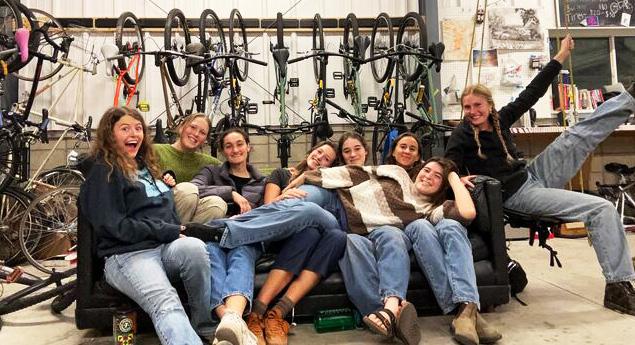

On March 20, novelists Francesca Capossela PO ’18, David Connor PO ’15, Julius Taranto PO ’12 and Tyriek White PZ ’13 convened to discuss what it means to make a career out of artistic practice.

time radio plays into modern theatrical accounts of female presidential candidates’ lives. Throughout the night, the audience gasped and laughed at the candidates’ sly quips and clever jabs at American culture.
“What you assume will be a linear exploration of a little-known corner of American presidential history explodes in a grotesque panoramic survey of 19th-century society, mysticism and gender inequality,” Kuritsky said.
Kuritsky also explained the importance of getting former female candidates’ stories on the radar.
“There’s a powerful feminist message of self-empowerment and speaking truth to history, but also the deeper mystery of being human, impossible choices in amoral times and [of] who controls the narrative,” she said.
Listening to snippets of the podcast, the audience sat enraptured by the voices of the entirely female-identifying cast that narrated both women’s and men’s characters.
The producers spoke on this intentional choice in a question to the audience.
See PODCAST on page 4
Trending upward: 5C women coaches share their stories, highlight the need for progress in the NCAA
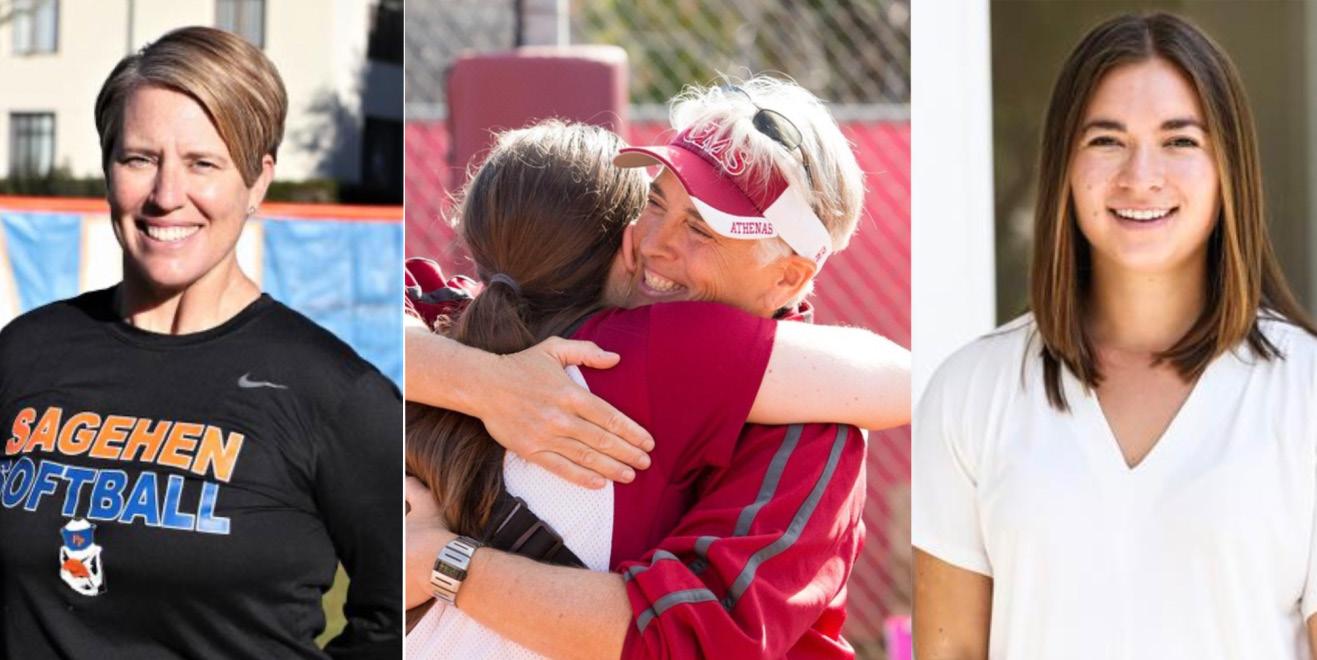
CHARLOTTE RENNER
Fifty-two years ago, the passage of Title IX prohibited sex-based discrimination in any school or other education program and altered women’s sports forever. Since that momentous day, women have continued to fight for positions of leadership in the NCAA. While icons such as women’s basketball coaches Tara VanDerveer of Stanford or Pat Summitt of University of Tennessee serve as examples of the progress that has been made, the war is not won and the fight for gender equality in coaching continues through the country. Across all NCAA divisions, women make up 42 percent of head coaches for women’s teams but only 6 percent of men’s teams. In Division III athletics, the statistic is only 1.8 percent more equitable, with 43.8 percent of women’s teams coached by women. Despite its already inequitable statistics, both NCAA athletic programs in Claremont fail to meet this standard. Pomona-Pitzer (P-P) sits below the national average with a mere 37.5 percent of female head coaches. Even further below, with only five of 17 Claremont-Mudd-Scripps (CMS) women head coaches, CMS scores a lowly 29.4 percent.
Despite the low number of women coaches, according to CMS softball coach Betsy Hip-
ple, the 5Cs are able to retain these coaches for long periods of time as a result of the supportive environment fostered within the athletic departments.
Hipple previously coached the Athenas from 2005 to 2017 and has since returned for the 2023-2024 season. In her time, she has taken CMS to the NCAA National Championship tournament six times. She spoke about the positive experience that she’s had in her years coaching in Claremont.
“I think the Claremont Colleges as a whole are pretty incredible places to work or to go to school,” Hipple said. “I just think [Claremont] is a very special place. I think in terms of being a female coach of a female sport, I’d be hard pressed to find an address where you were more supported and more believed in and I think that’s across the street too.”
Previously playing at DIII Shippensburg University and then coaching at Division I George Washington University, P-P softball coach JoAnne Ferguson said she has also witnessed the benefits of a small DIII athletic program that focuses on supporting its athletes and coaches, especially for women.
“It was great to come back and have a more holistic approach to coaching and teaching,” Ferguson said. “I have great female role models in this department and support administratively, so I feel like it’s a very positive place to be a woman coach.”
See COACHES on page 9

The student newspaper of the Claremont Colleges since 1889 INDEX: News 1 | Arts & Culture 4 | Opinions 7 | Sports 9 FRIDAY, MARch 22, 2024 CLAREMONT, CA VOL. CXXXV NO. 17
OPINIONS
ARTS & CULTURE
Catching herself in an unnecessary apology, Parishi Kanuga CM ’26 is peeved at the instinctual “sorry” that women are socialized to.
AShA JAIN • ThE STUDENT LIFE
cOURTESY: PITZER GREEN BIKE PROGRAM
NIKKI SMITH & YAHJAIRI CASTILLON
The Pitzer Green Bike Program recently launched an initiative to host women and gender-nonconforming hours each Tuesday from 3 to 5 p.m. See BIKES on page 2
cOURTESY: cMS AND P-P AThLETIcS LEFT TO RIGhT: Joanne Ferguson, Betsy hipple, Alaina Woo.
The Scripps Presents series hosted “A Simple herstory” podcasters Jocelyn Kuritsky Sc ’04, Jonathan Goldberg and Jennifer hall to speak about the country’s exhaustive track record of female presidential candidates. do,” Aguirre said. Kuritsky credits her background in theater and ability to participate in complex discussions with politically diverse friends with leading her to create the podcast. “A Simple Herstory” bends old-
BIKES: GBP spearheads specialized hours
continued from page 1
The following week, the GBP’s women and gender-nonconforming hours officially began. Staff members noted that students were quick to take advantage of the new hours, which evoked an overall positive response from the community. Britton also noticed that the new hours seemed to make some students feel more comfortable with the GBP in general.
“Telling [students] that we have a women’s hour makes it more approachable even if they can’t come to the hour,” Britton said. “It shows that we’re trying.”
Lao suggested that the new hours reflect well on Pitzer overall, noting that the GBP is often brought up to prospective students.
“Having it be something that the students actually want to be involved in and don’t feel intimidated or scared by … something [that is] by and for the people is good,” she said.
Along with addressing student anxieties, the initiative offers female and gender-nonconforming staff members an opportunity to improve their skills as mechanics.
“Not only is it beneficial for the outside community … it’s been fostering a positive learning environment for us,” Haddad said.
Still, despite these successes, Haddad explained that working during the new hours could be stressful at times.
“There are also not that many of us working,” she said. “It does get overwhelming.”
Salomonsson felt similarly, encouraging more women and gender-nonconforming students to apply to work at the GBP next semester.
“We’re getting so many people during those two hours — sometimes we do feel a little bit overrun,” Salomonsson said. “For the next coming year, if you’re a woman and you do want to apply to work at the GBP, you should so that we never feel understaffed because of the ratio of men to women.”
New residential themed communities pilot at Pomona College for the upcoming school year
AMEYA TELI that and to connect with some students that have similar interests … similar to the [Outdoor Education Center (OEC) themed community].”
Starting in the fall of 2024, Pomona College will introduce two new housing options for all rising sophomores, juniors and seniors: the Lavender/Audre Lorde Gender & Sexuality Residential Themed Community and Roaming Together: Outdoor Adventure (OA) Residential Themed Community. An announcement was sent to all Pomona students Feb. 15 via email informing them of these residential themed communities and more information was given in an information session Feb. 21. Announcements of acceptances into the themed halls were announced March 8.
Steven Jubert, associate dean of Campus Life and director of Residential Life at Pomona, explained that these communities are meant to foster opportunities for students to find connections outside of a classroom setting.
“The goals are simply really to provide another way for students to engage outside of the classroom,” Jubert said. “This will be an opportunity for students who have an interest … with some of the things that are happening in the Queer Resource Center (QRC) to tap into
The Lavender/Audre Lorde Gender & Sexuality Residential Themed Community will be located in Walker Hall next semester and will be centered around learning and engaging with topics of gender, sexual and romantic orientation, sexual health and social justice in a partnership between Housing and Residence Life (HRL) and the QRC.
The Roaming Together: OA Residential Themed Community will be located in Harwood Hall next semester and will be centered around exploring interests in outdoor topics such as recreation, skill-building, local outdoor opportunities, environmental conservation and sustainability in a partnership between HRL and the OEC. Students interested in the residential themed communities had to submit an application by March 3 consisting of responses that expressed their interest in the community of their choice. Accepted students are guaranteed a single room in Harwood or Walker Hall, depending on their assigned community.

Anna Marston PO ’27, a student who applied to live in the OA community, noted many pros to applying to live in such a community, including skipping the room-drawing process and having the guarantee of a single. Another upside Marston noted was the ability to find a connection with and learn from peers who share similar interests.
“I want to get more exposure to other outdoor activities I might not normally do because obviously everyone living in the community is not going to like exactly the same outdoor stuff,” she said. “I’m hoping to learn more from others and what they like to do.”
These residence halls are a relatively new concept to Pomona with Oldenborg being the most similar to these new halls.
Oldenborg is an existing themed residence hall at Pomona that is organized based on spoken languages, with the goal of helping students learn and develop community and culture.
“We have Oldenborg, which is a living and learning community … and that’s been a staple here,” Jubert said. “Oldenborg [is] the closest thing to that [on] a larger scale and has a very historical component.”
One difference between these communities and Oldenborg is that students who live in the communities in either Harwood or Walker will be among other students not in the community.
“You could have a person that’s in the themed community and then a few doors down someone that’s not,” Jubert said. Jubert noted that one reason these themed communities are being piloted is to gauge student interest in the offering. This comes in contrast to Oldenborg, a community that takes up an entire building.
“I don’t think that there are any plans to have a full building dedicated to one of these particular communities,” Jubert said. “We’ll see … if there’s a huge interest maybe, but I don’t foresee that being the case. It’s something that’s new and we want to see how it turns out.”
Abraham Arias PO ’24, last year’s North Campus representative — a student elected by students living on Pomona’s North Campus to represent their interests to the Associated Students of Pomona College Senate — commented on the similarities between Oldenborg and these affinity-themed communities.
“I think Oldenborg was kind of like a test run for what that could look like and it was successful,” Arias said. “So I think we’re basing it more on our own experience as an institution.”
In developing these new residential themed communities, Jubert noted that conversations with student representatives were of high importance.
“We had some conversations briefly last year with some of the … North Campus and South Campus representatives … and then it wasn’t until this year where we actually got to some of the implementation of it,” Jubert said.
As noted by Jubert, the housing committee, comprised of student representatives such as Arias, played a large role in the discussion surrounding the creation of these communities thanks to their knowledge and observations of housing life at Pomona.
“As a North Campus rep, I noticed there’s a lot of disconnect in terms of dorm communities; people don’t really interact with their neighbors a lot,” Arias said. “I think it’s going to be a really positive experience … I’m excited to come back years later and hear about how it went. I’m expecting good things.”
Jubert noted another especially important part of developing these communities was to maintain a close relationship with campus partners, especially the ORQ and OEC.
“We [touched] base with the QRC and OEC about some of the work that they’re doing and how we can probably continue some of the partnerships that we already have with some of the work that they’re doing,” Jubert said. “They were on board to partner with us to do some of this and so then we started to explore what the opportunity will look like.”
Reproductive medicine and policy: Abortion and the Supreme Court with Jaclyn Serpico
On Thursday, March 7, Health Bridges invited Jaclyn Serpico, a fellow at the UCLA School of Law Center on Reproductive Health, Law, and Policy, to talk to students about the intricacies of reproductive healthcare and her research on reproductive rights.
The talk took place in Pomona College’s Hahn Hall and is the latest in the speaker series put on by Health Bridges — a student-run nonprofit organization under the Draper Center — which has focused on gender and health. With funding from and in collaboration with the Berger Institute at Claremont McKenna College, this series has been going on for the past two semesters. Previous talks have covered topics such as transgender rights, HIV prevention and public health equity.
Abigail Krenz PO ’26, a student organizer for Health Bridges, outlined how Serpico’s expertise and the “hot topic” of abortion aligns with the speaker series’ mission.
“What we want to bring with this
series is more of an interdisciplinary understanding of health, so that means bringing in the policy expert and the lawyer in order to bring more diverse perspectives,” Krenz said. “I hope that the speaker series can open engagement on topics that are difficult and as a student organization, we have a role in ensuring that we’re contributing to a campus that really thinks about issues of justice and equity.”
Before getting into the nuance of current Supreme Court cases, Serpico briefly discussed the research that backs medical abortions.
“In the United States, we use two drugs; that’s the best practice and most evidence-based, safest and most effective way to do it,” she said. “The first one is called Mifepristone, which you take to end the pregnancy, and then a second medication called Misoprostol, which you take about 24 hours later, expels the pregnancy.”
Serpico explained the unique learning process for medicine and for Mifepristone specifically. “[After] 16 years of Mifepris-
tone being allowed … there was a more effective way to do it because doctors could prescribe different doses and figure out what was working best for people,” she said.
Since its Food and Drug Administration (FDA) approval in September 2000, many changes have been made to improve distribution and administration of the drug.
Serpico also explained the COVID-19 pandemic’s impact on the expansion of telemedicine, which allows for virtual doctor visits that can prescribe medicine remotely. This development led to the 2021 removal of in-person dispensing requirements for Mifepristone, a change made permanent in December 2023.
“Before this, you had to actually go to a physician who would give you the pill, which was an unnecessary regulation,” she said.
“Whereas once everything started to move toward telemedicine you could just teleconference and the pill could be mailed to you.”
In November 2022, a group of anti-abortion health professionals

called Alliance for Hippocratic Medicine (AHM) filed a suit against the FDA for its approval of Mifepristone in a Texas federal court. The choice of filing it in Texas was intentional, as U.S. District Judge for the Northern District of Texas Matthew Kacsmaryk — appointee of former President Donald Trump and a conservative Christian — demonstrated a record for leaning toward anti-abortion viewpoints.
For example, Kacsmaryk wrote an article in 2015 in which he claimed a woman’s right to reproductive health is simply an “erotic desire of liberated adults.”
Kacsmaryk proceeded to rule in favor of AHM and this ruling rolled back the FDA approval of the drug. Serpico made a point to highlight that this suspension relied on the scientific evidence of two studies that have since been retracted. Serpico explained the message that Kacsmaryk’s ruling had. “[The ruling said that] the FDA should never have approved this drug and it can’t be sold in U.S. markets,” she said.
The case has since moved from the district court to the U.S. Department of Justice, then the Fifth Circuit Court of Appeals and now to the Supreme Court, which will hear the case this Tuesday, March 26.
Serpico pointed out a couple of issues consequential to the court ruling in favor of rolling back Mifepristone.
“[It] would be required to be dispensed in person and only by licensed physicians,” she said. “The drug labeling would also be out of date. It would recommend this unnecessarily early gestational limit. It would recommend a dosing regimen that is less effective and causes more side effects. So that would obviously not [be] good for patients.”
Continuing with her theme of Supreme Court cases, Serpico also spoke about the upcoming in vitro fertilization (IVF) case, which will be heard this summer. In this case, the Alabama Supreme Court ruled that couples whose IVF embryos were accidentally destroyed while in storage at a facility in Alabama could file wrongful death lawsuits, essentially equating the value of an embryo to that of a child’s life. Se-
roico explained the context around this ruling.
“The background as to why this is happening is the fetal personhood movement, which is a decades old movement in the United States to confer the full legal and constitutional status of a person to embryos or fetuses before birth,” she said.
She further explained how the fetal personhood movement was being established in the state.
“‘Children’ in the Alabama Supreme or State Constitution includes not only children who are born, but also fetuses and embryos, including embryos that are frozen in vitro and not in the uterus,” Serpico said.”That has been hugely hugely destabilizing to IVF practice in Alabama and is having ripple effects in other states because providers in other states are getting nervous.”
Serpico explained her motivation for giving the talk, emphasizing the importance of discourse around this topic.
“One, it’s important for folks to be educated about what’s happening,” she said in an interview with TSL. “Two, I think it’s important for people with different levels of knowledge, different perspectives, different opinions, to be able to talk about controversial issues. It helps to have the facts when you’re talking about things and to be able to have your conversations really be grounded in the facts.”
Students in attendance found the talk to be timely and topical, as well as having provided an understandable overview of complex issues.
“I think it’s a very relevant issue, especially with all the Supreme Court hearings coming up this summer,” Stella Markey SC ’24 said. “On the news we hear a lot about things that happen at a national level, but [Serpico] really delved into things that have not gotten as much attention.”
Along with discourse and education on abortion and its role in the United States, Serpico suggested that civic and political participation is a way in which people should get involved.
“I know you hear it a lot, but vote; a lot of this is determined democratically at the ballot,” she said.
“Judicial elections are extremely important. If you live in a jurisdiction where judges are elected, that’s hugely, hugely important and something that often goes unnoticed.”
PAGE 2 MARch 22, 2024 News
cOURTESY: POMONA cOLLEGE
SAGE HARPER & YAHJAIRI CASTILLON
On Thursday, March 7, health Bridges invited Jaclyn Serpico to talk to students about reproductive healthcare and her research on reproductive rights.
QUINN NAchTRIEB • ThE STUDENT LIFE
‘Not ready to eat’: New sign at McConnell tells diners to wash their fruit
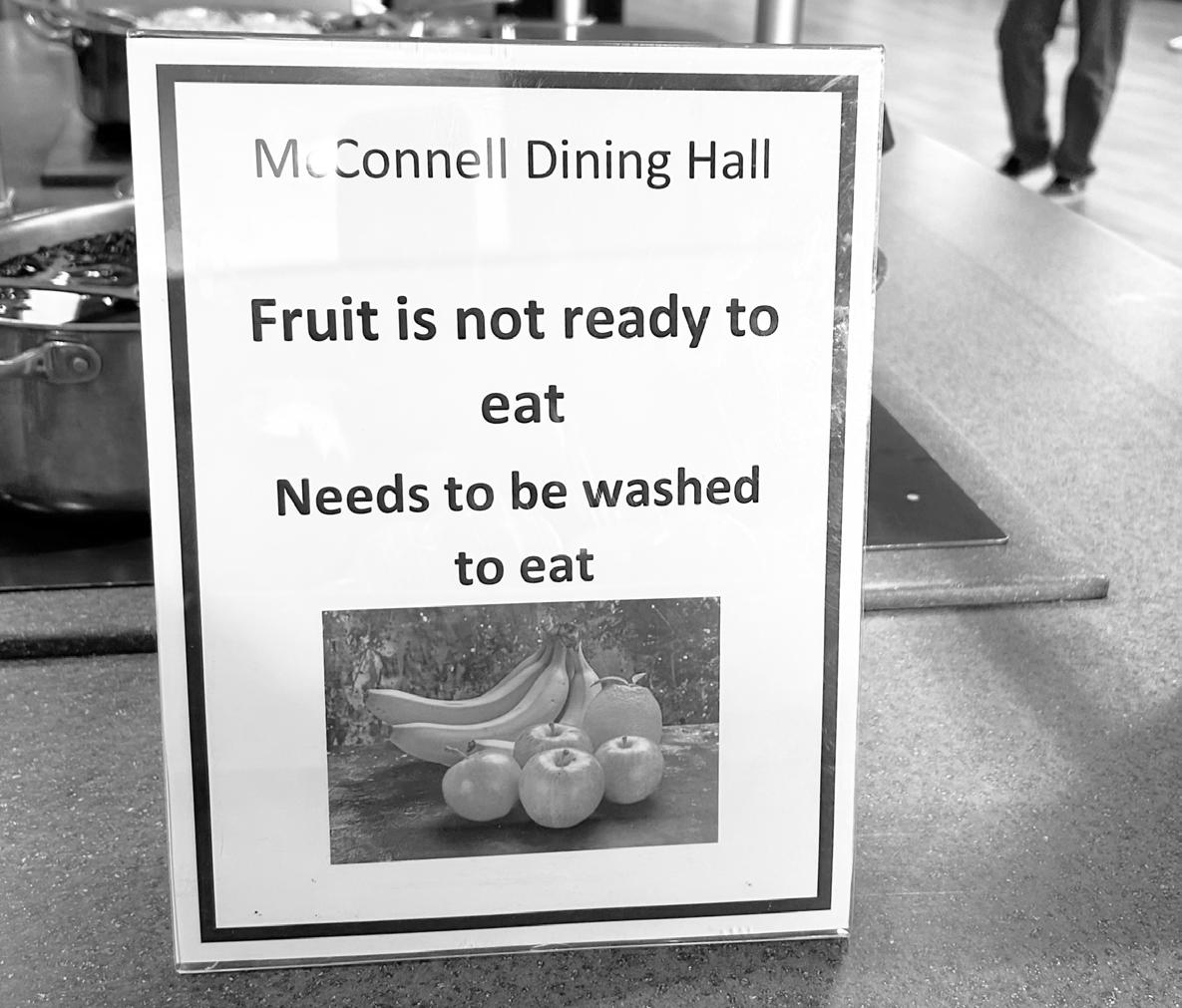
“Fruit is not ready to eat. Needs to be washed to eat.” The sign was put up by General Manager Miguel Menjivar and Executive Chef Marcos Ríos. Both are from the Bon Appétit Management Company, a restaurant company which provides food management
services to universities across the country.
Bon Appétit’s website indicates a “farm to fork” emphasis in their catering. Menjivar reaffirmed local farms as the source for McConnell’s produce.
“Everything we put out comes in the day before; it’s not refrigerated,” Menjivar said. “The sign is basically letting you know that you should be cleaning the fruit. All the fruits, because they are organic, have a label on there that shows that they come from a box, so they haven’t been cleaned.”
The two McConnell dining heads explained that the fruit is washed once it is picked at the farms, but is not washed again at McConnell because of the resources needed to wash them again in-house.
“We don’t have a sink to drain [the fruits],” Menjivar said. “We would have to wash them, drain them: It would require quite an ordeal to do it. So they’ve never been washed here.”
Ryan Chen PZ ’27 — the owner of the McConnell Apple Enthusiast account on Instagram, where he uploads photos of dining hall apples — described how not washing the fruits makes consuming them in the dining hall a hassle. “I started [my] account because I am a fan of the produce at McConnell
and I wanted to let people know when they had good fruit in,” Chen said. “Part of me does wish that [the fruits were] pre-washed so that we could have [them] with our meals.”
He also emphasized how, while beneficial, the sign may dissuade diners from eating fruit entirely due to the additional hurdle of having to wash them.
“We already see a good percentage of the fruit in the dining hall go bad sitting in the trays and I don’t think this will exactly encourage people to eat more fruit,” Chen said.
Bon Appétit also manages the dining services at Scripps and Claremont McKenna Colleges (CMC). While there has been no sign put up at Scripps, CMC has a similar sign to Pitzer’s reminding diners to wash fruits before consumption.
“It is a Bon Appétit sign, but it wasn’t a Bon Appétit decision,” Menjivar said. “It’s just something we thought made sense and we just wanted to put it out there.” Menjivar elaborated on communication between the three dining halls surrounding management.
“While we are [all] run by Bon Appetit, the way we run and how we do our food is different because every account has its own personality,” Menjivar said. “We do have the same managers, though: If they have
had the same discussions [about the fruit], I couldn’t tell you that. But we don’t coordinate.” He stated that the farms from which all three dining halls source their food are probably different.
“We have a number of farms that we can work with,” Menjivar said. “We just particularly find some that are able to keep up with what we put out there. We have two, three farms that we use. I don’t know if they’re the same ones that they use. They have access to them, for sure, because we have the same purchasing system, but they could have picked other ones. These ones just seemed to work for us.” Bon Appétit staff at both CMC and Scripps did not respond to TSL’s inquiries about their fruit policy.
Menjivar emphasized that the McConnell staff works diligently to make their diners as healthy and informed as possible.
“We’re always going over everything that we do and we try to make sure that everything is updated and working for what we’re doing now,” Menjivar said.
Ríos underscored that the best way to handle the fruit situation, given McConnell’s current resources, was to make diners aware of the cleanliness of the fruits.
“Our best practice is for you guys to have a sign,” Ríos said.
‘The Making of the American Calorie & Metabolic Metrics of Empire’: Dr. Athia Choudhury discusses the rise of the calorie and modern diet culture
NITYA GUPTA
CW: eating disorders and diet culture
On Wednesday, March 6, Northeastern University Chau Mellon Postdoctoral Fellowship candidate Dr. Athia Choudhury gave a talk titled “The Making of the American Calorie & Metabolic Metrics of Empire.” The event, held at Pomona College’s Gender and Women’s Studies House, examined the historic emergence of modern diet culture through various health and wellness technologies, focusing on the rise of the calorie.
Choudhury is a postdoctoral associate in Duke University’s Asian American and Diaspora Studies program. She is an intersectional feminist thinker, working at the conjuncture of food studies and transnational feminism.
Event organizer Aimee Bahng, an associate professor and coordinator of the Gender and Women’s Studies program, explained that she invited Chodhury to speak because she said she finds the multifaceted nature of her work to be inspiring.
“Professor Choudhury is a fantastic scholar at the intersection of disability studies, fat studies, gender studies, postcolonial studies and comparative ethnic studies,” Bahng said.
At the talk, Choudhury started with a personal anecdote, explaining how her life always revolved around calories. Since the age of 12, she said she attempted numerous strategies to lose weight — fad diets, appetite suppressants, slimming malts and laxatives — noting that she attempted most of these under the supervision of healthcare professionals.
“The idea of health and reaching towards it at whatever cost meant that a world I had only known as punitive, violent and humiliating towards my body would finally let me live,” she said. Choudhury then delved into the history of the calorie, explaining how
it went from a measure of heat energy to a measure of energy content of food when chemist Wilbur Atwater began conducting calorimetry and metabolic experiments on humans for military applications. Following this, the calorie played a central role in the movement of euthenics, which emphasized human wellness and the creation of universal standards for public welfare worldwide.
Choudhury explained that, as a part of euthenics, ‘living exhibitions’ were used to capture the attention of Americans and encourage them to support health reform abroad. However, she noted that this move caused many Americans to try to shun and eliminate the successful health practices of other cultures.
Citing an example of a living exhibit in 1904 at a World Fair, Choudhury explained that the exhibit showed Igorot Filipinas “barely dressed in scraps of clothes, living in straw huts, using stone tools and butchering and eating dogs to elicit glee and disgust from the audience.”
“Historians have noted that the consumption of dogs for certain tribes in the Northern Highlands was part ritual and part medicinal practice,” Choudhury said. “Yet, the [living exhibits] spectacularized dog-eating daily, galvanizing the American public to support health and hygiene reform in the Philippines.”
After this, the calorie became a mass-market tool, used in training manuals, recipe booklets, food labeling and nutritional media material. As a result, poor communities of color, Native boarding schools and prisons became test sites for nutritional re-education.
“Food as fuel for the body allowed reformers to train the poor labor force into consuming economic and nutrient dense foods to replace cultural and ethnic foods,” Choudhury said.
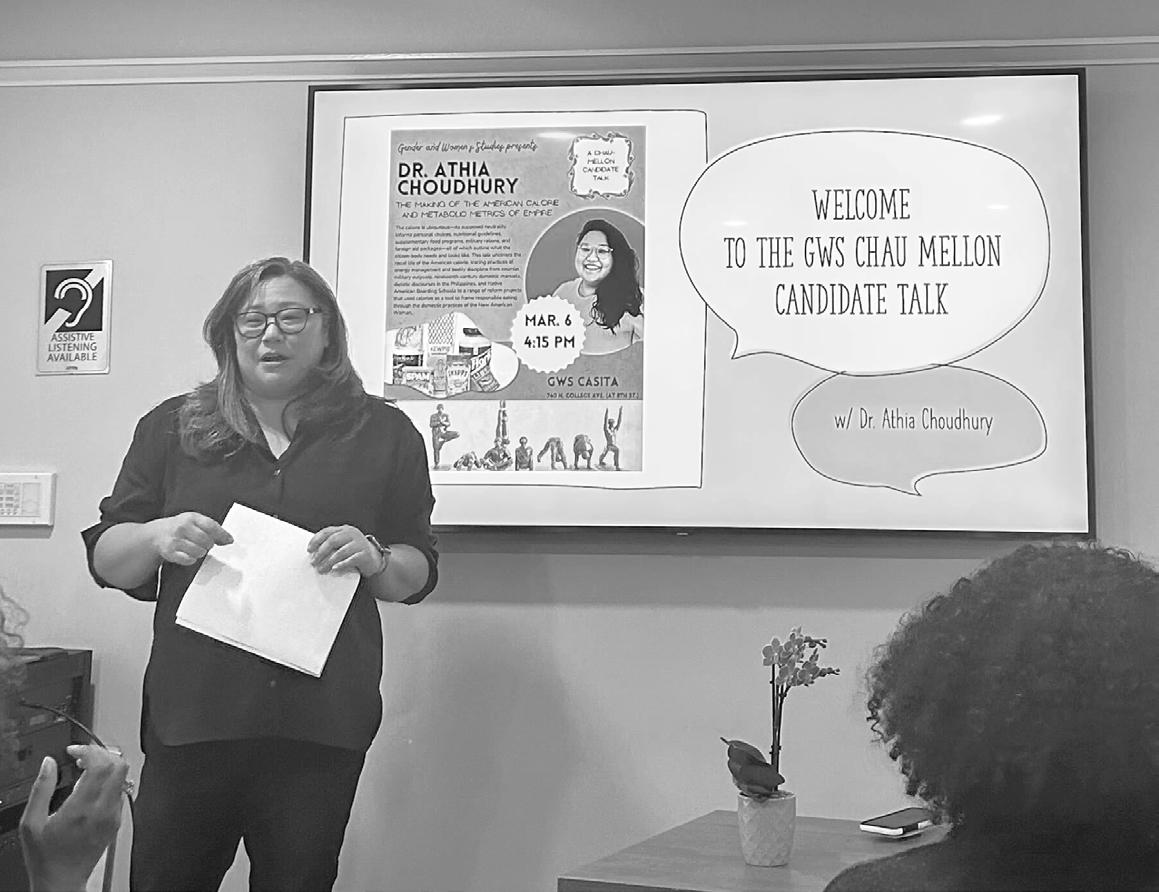
“It’s important to recognize how the calorie fundamentally changed our reasons for eating.”
According to Choudhury, this led Americans to fixate on food and body weight, with body weight being used by the state to determine citizenship and sovereignty over Native communities.
Choudhury cited an example from the Carlisle Indian School collection — one of the largest digital repositories for archival material from Native boarding schools — where there are hundreds of weight charts that were used for transfers, discharges and discharge denials.
“Families were denied reunification based on the child’s weight — either that they were previously overweight or underweight and that under the state’s nutritional watch, the children were healthier and therefore better off remaining at the school,” Choudhury said.
Choudhury added that weight became an index of child welfare and that health data was used to measure the “Native communities capacity for caretaking and sovereignty.”
She continued that later, in the 20th century, the calorie went from being state regulated to self-regulated, when American women began to regulate calories in their homes so that they could feed soldiers.
This created a link between calorie regulation and national responsibility that can still be seen in all kinds of public health initiatives, such as Michelle Obama’s Let’s Move Campaign.
“At first, [the campaign] was about training parents and children in good nutrition, continuing tactics that said that some bodies must be surveilled and eliminated for the good of the nation,” Choudhury said. “[At a press conference], Obama echoed sentiments that litter the
USDA and the Bureau of Home Economics archive — that fatness threatens the very vitality of the nation.”
At the conference, Obama characterized childhood obesity as a national threat with far-reaching consequences.
“Childhood obesity isn’t just a public health threat, it’s not just an economic threat, it’s a national security threat as well,” she said in 2010.
Choudhury added that, around the same time, calorie regulation at home led to competing images of American femininity. Women would either restrict calorie intake to get a willowy figure, or use calorie intake to improve health and human output.
But, Choudhury said, this leads to health issues like Orthorexia Nervosa, a hyperfixation on food quality, nutritional value and purity of the foods one consumes.
“It is an eating disorder defined by a desire to know the scientific, quantifiable and material conditions in which a food item has been grown and harvested and how it will interact with the body on the cellular level,” she explained. “Ultimately, it is food literacy that has gone too far.”
Choudhury ended the talk by explaining that it is important to recognize that these racialized systems of eating are embedded in people’s mindsets, but that there is a possibility of cultivating a relationship with food and eating that is honest and indulgent.
Bahng echoed a similar sentiment, explaining how recognizing racialized systems is a part of studying Gender and Women’s Studies.
“The things you take for granted in your everyday life, the food that you eat, the clothes you put on your body, these are all inflicted with important histories, often of racial capitalism,” she said. “A part of our line of study in Gender and Women’s Studies is to inquire after those histories and the significance they play on how we understand our relationships to the world.”
MARch 22, 2024 PAGE 3 News
On Mar. 6, Pomona college’s Gender and Women Studies Department hosted a talk by Dr. Athia choudhury on diet culture and the rise of the calorie.
NITYA GUPTA • ThE STUDENT LIFE
KAHANI MALHOTRA
Amidst the hustle and bustle of Pitzer College’s McConnell Dining Hall, a recently added sign sits beside the tubs of apples, oranges and bananas:
EShA chAMPSI • ThE STUDENT LIFE
A new sign at Mcconnell Dining hall prompts questions about the cleanliness of the fruit and the steps that go into preparing it.
MUDD SUMMER SESSION M AY 2 0 – J U LY 19 2024 Classes offered online and in-person Three- and six-week courses Taught by HMC faculty $4,250 (three-credit course) hmc.edu/summer-session Registration now open View program details, courses and registration information at GET AHEAD. IGNITE YOUR INTELLECTUAL CURIOSITY.
Homegrown talent: 5C alums turned novelists speak on their debut books
On March 20, the 5C community gathered at Rose Hills Theatre to hear from four novelists who once roamed the halls of the Claremont Colleges themselves. The panel featured Francesca Capossela PO ’18, author of “Trouble The Living,” David Connor PO ’15, author of “Oh God, The Sun Goes,” Julius Taranto PO ’12, author of “How I Won a Nobel Prize” and Tyriek White PZ ’13, author of “We Are a Haunting.”
The reading was organized by Jonathan Lethem, an English professor at Pomona College. Lethem convened the panel to show 5C creative writing students what it looks like to transform artistic practice into a professional career.
“I do hope that [the panel] makes people see what’s possible,” Lethem said. “[That it] connects [students’] practice as undergraduates to the development of their artistic practice in the real world, including publication.”
Each author, introduced by their former faculty mentor, read aloud a brief excerpt from their debut novel and then participated in a Q&A. The excerpts explored the complexities and sacrifices of familial relationships and the process of “seeking” in a chaotic world. Pomona W.M. Keck Professor of English Kevin Dettmar introduced Capossela. Her reading featured two sections of her lyrical novel, “Trouble The Living,” told from the point of view of a mother in the 1990s in Northern Ireland and her daughter in 2016 in Southern California. The mother recounts her childhood trip to the border of Northern Ireland.
“It was the first time I had seen a slice of it that was not swarming with Brits,” Copossela read. “This was the border’s naked underbelly, what it looked like without its armor. She was showing us its weak spots, the places where we could do damage.”
The daughter’s narrative includes a vivid account of her abortion, capturing her acute emotions and seeing them through as they give way to reflection.
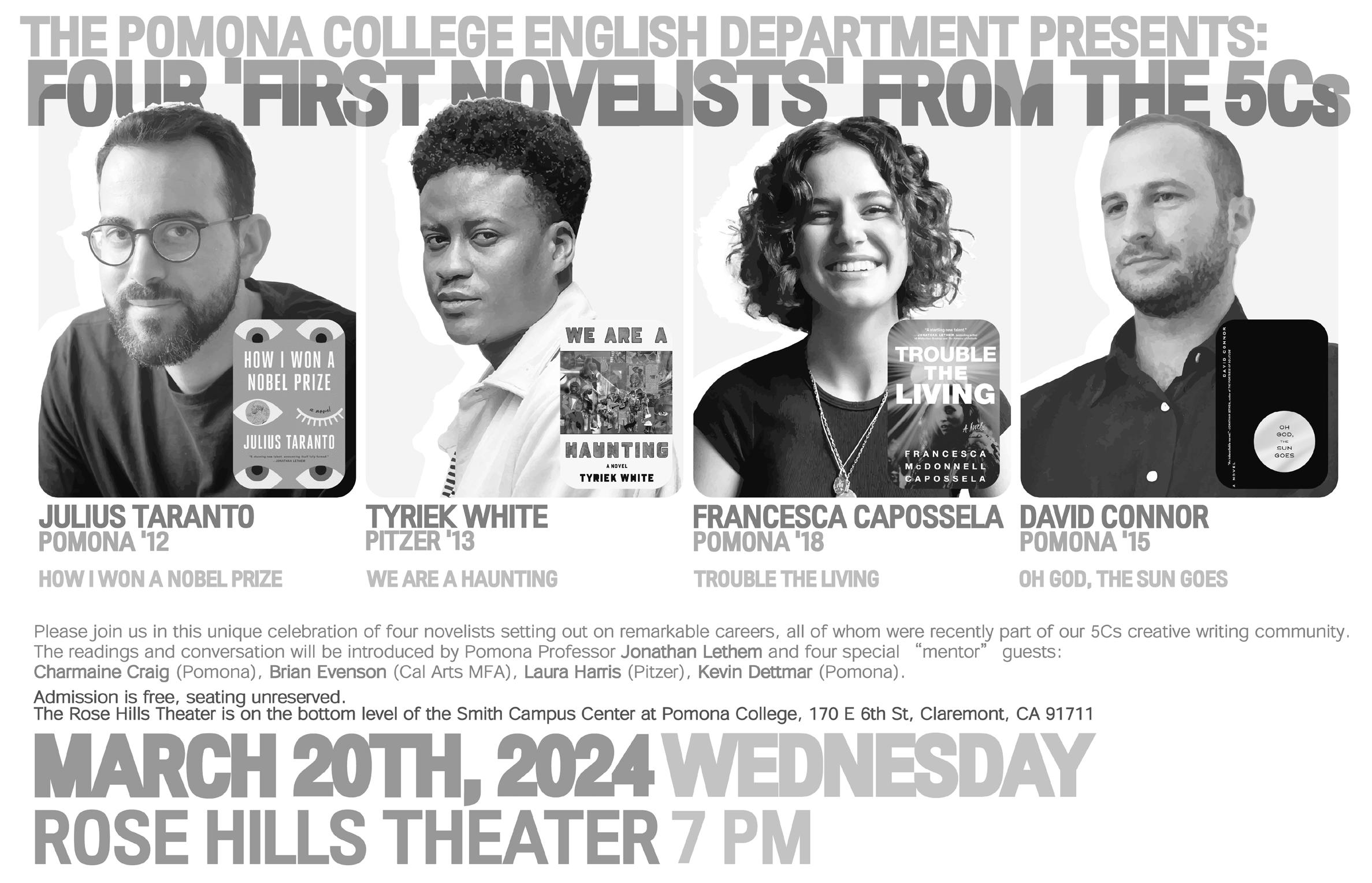
On March 20, novelists Francesca capossela PO ’18, David connor PO ’15, Julius Taranto PO ’12 and Tyriek White PZ ’13 convened to discuss what it means to make a career out of artistic practice.
Connor was introduced by Brian Evenson, one of Connor’s professors at the California Institute of the Arts, who spoke on the counterintuitive and discerning nature of Connor’s writing. “[Connor] strip[s] things down to their most basic components,” Evenson said. “And then somehow mak[es] those components resonate even more than they normally would.”
Connor’s novel follows a man searching for the sun, which has gone missing. Connor read an evocative and ethereal description of Sun City, Arizona, where the narrator travels on his quest and where he hopes to find Dr. Higley, who claims to know the Sun’s whereabouts. “The bird’s vision taking in an ae-
“It was a quiet civil war, a fight for autonomy … It was recognizing my own body, my need to protect it, the love I had for it … Nobody could love me out of the pain or forgive me from the burden,” Copossela read. “In the end, I felt lucky … to be in control of my body … It was what we all wanted, to choose our own freedom, to choose our own pain.”
MOMENTS TO SAVOr
rial view of the scene, which reveals a town in the shape of a perfect O, a circle of houses surrounding a radial center and expanding out towards the desert and perfect symmetry,” Connor read. “A Sun City indeed, a town in the shape of a sun. If Sun City appeared in a dream, it would be a dream induced by the heat of the desert, or induced in a state of delusion brought on from driving too many miles.” Taranto’s novel features a graduate student who follows her mentor to a university on an island for “canceled” artists and academics, tracing the ways this experience impacts her relationship with her partner. Much of the land was originally allocated for conservation. “Moist morning light refracted off the great cliff, the rocky beaches, immaculate lawns, the little town was all white painted, clever black
trim, gray shingles, city brick,” Taranto read. “[And] boats jostled and claimed in the marina.” Pitzer College’s Professor of English and World Literature Laura Harris introduced White. White’s novel “We Are A Haunting” is a multigenerational saga about a Black family in Brooklyn that charts their interactions with the supernatural.
The excerpt White read featured Colly, the novel’s protagonist who recently lost his mother and whose father was rarely home. White described Colly’s piercing grief as he lies motionless listening to old music.
“Just a few of the verses in my hands, the shape of it on the page, the critical process that happens between writing a thing and saying it,” White said. “I saw your face clearer than the dead. It had been over a year but … I had never stopped crying. I just did it quietly.”
When asked about the most difficult part of the writing process, Connor emphasized finding balance between the solitude required for writing and the social demands of daily life.
“Figuring out how to live, at least for me, how to live in the world of my book and living in the world at the same time was maybe the hardest part,” he said. The novelists advised current students to cherish their years in Claremont and to make an effort to connect with professors.
Attendee Ariana Makar PO ’24 said that the panel challenged her perception of what it means to be a career writer.
“I always think of writers as older individuals,” Makar said. “And to see people … who were in the same community as me … really brought it closer to me.”
Frary cereal, coffee and fries oh my!
EMILY KIM
College life is full of so many sweet moments. As cheesy as that sounds, I can’t help but think about it more and more as the semester goes on. Even when I’m stressed about assignments and Zoom meetings and the mountain of readings that I have to complete, it is the silly moments with friends that make the stress bearable.
A couple of weeks ago, I stumbled into Frary with a lot on my mind. I had been constantly on the move that day and had not once stopped to take a breather. I also had a major assignment due that night that was frustrating me. For days, it made me want to bang my head against a wall. Evidently, I needed to clear my mind — but all I could think about was eating a quick dinner and then locking myself in my room until the assignment was done.
I grabbed my food and started perusing the dining hall for a place to sit when all of a sudden I ran into my friend Rachel Cho PO ’27. She was having dinner with our other friend, Eliana Yi PO ’24, and asked if I wanted to join them.
For a split second, I hesitated. “What about the work I have to do?” I thought to myself. The hour that followed, however, ended up being the perfect destresser — the mental break that I so desperately needed.
Rachel, Eliana and I caught up and cackled over what happened that day in Rachel’s chemistry lab, as well as in Eliana’s wheel-throwing pottery class. We lamented over

how tired we were and vowed to try getting a proper night’s rest that evening, regardless of the assignments that oh-so-eagerly awaited our attention. We talked and talked and talked and once we had finished our food, we collectively agreed that it was time to grab a sweet treat. We didn’t want our dinner to end here — our conversations were far from over.
So, the three of us emerged from our seats and started perusing that night’s Frary dessert options. When none of the baked goods intrigued us, we decided to inspect the ice cream selection. When nothing from the vivid array of ice creams caught our attention, we realized that we would have to get creative with our sweet treats.
We agreed to go our separate ways to assemble our concoctions and meet back at our table afterward and regroup — and when I returned, I was met with the most amusing sight. Eliana had a bowl of Froot Loops and Frosted Flakes (no milk) in front of her, Rachel had a plate of onion rings and fries in hand and I had a vanilla latte.
We chuckled at how different our post-dinner palate cleansers were. Rachel and Eliana poked fun at me for my 7 p.m. coffee (I can sleep just fine with coffee in the evening) and I made sure to do the same with Eliana’s curious cereal selection and Rachel’s not-so-sweet “sweet” treat.
By the time we finally left the dining hall after chatting over our coffee, cereal and fries, I smiled to myself. Even though the work I had yet to do had not changed, I felt rejuvenated. I flipped back to the photo on my phone that I had snapped of our “dessert” selections and laughed. “These moments, rather than the assignments, are what I’m going to remember of my college experience,” I thought to myself. “These are the moments that I don’t want to skip out on.”
Now that we are back from spring break, we are in the home stretch of the semester. Things will inevitably get stressful. I hope, though, that amidst the seemingly never-ending pile of work that we have to complete, we still take the time to eat with our friends, tease each other for our dessert choices and share some good hearty laughs.
Whether finishing up our first or last year at the 5Cs, our time here is short. These are the moments that we will remember.
Emily Kim PO ’25 is from Irvine, California. The next book on her reading list is Breast and Eggs by Mieko Kawakami, and she is currently feeling very grateful for the stash of coffee candy in her desk drawer.
PODCA st: ‘A simple Herstory’ remembers past candidates
continued from page 1
Hall asked the audience to consider which voices they preferred to listen to in a podcast. After reaching a general audience consensus that female voices were more desirable, she posed another question about the podcast hosts.
“Is it their natural speaking voice or do you think they might lower their pitch to make it a little more soothing for you to make it a little more palatable?” Hall inquired. “Why should it be that a woman’s voice might need to
be lowered to the register of a man’s voice in order for us to digest it better?” Goldberg, who wrote the podcast, described the difficulties in writing about women who “did not really exist in people’s minds,” unlike the famous historical figures immortalized in textbooks. Of particular note was season one’s Victoria Woodhull, who declared her candidacy in 1872 before women could even vote. For Goldberg, research entailed reading multiple
biographies of the same person at the same time and scratching large amounts of his work, ultimately crafting one version of the story. Goldberg described the infinite recursion one inevitably confronts when attempting to examine a single historical moment. He analogized the complexity of a historical timeline to that of a human life.
“We only have a finite lifetime to explain someone else’s finite lifetime in a long overlapping series of lifetimes,” Goldberg said. “We have to make choices. We have to use Victoria’s life to tell us something about our life, our
times. Historical fiction is not biography, it’s not about the past, it’s about using the past to comment on our present.” Kuritsky spoke on the importance of the podcast towards college students. “I think it’s really important for women to see that you can have all different kinds of perspectives and all different ideas about what’s right, what’s wrong, what’s feminist, what’s not, what makes a good person, what doesn’t make a good person,” Kuritsky said. Kieran Saucedo HM ’25
noted his appreciation for Kuritsky, Goldberg and Hall’s narrative style.
“[Fictional storytelling is useful] as long as you’re upfront or honest about the choices that you’re making,” Saucedo said. Goldberg highlighted that the podcast’s stories let the complexities and gray areas of history breathe.
“A simplification of history isn’t a collection of what happened,” Goldberg said. “It’s a collection of atypical moments strung together stretching across time.”
PAGE 4 MArch 22, 2024 Arts & Culture
cOUrTESY: POMONA cOLLEGE ENGLISh DEPArTMENT
ANAYA VINAY
VANESSA hO • ThE STUDENT LIFE
Updating the ‘American Experiment’
There are archaic stereotypes about Europe versus America that persist today: Americans are all about hustle culture, Europeans laze around in cafes all afternoon before going to work, the French are always on strike, etc.
The roots of these stereotypes — believe it or not — lie in early cultural exchanges between Europe and the (then) newly-founded United States.
Alexis de Tocqueville, in his infamous “Democracy in America” which he published after visiting the United States in the 1830s, articulated a central dichotomy that would define the distinction between European and American cultures from then on.
“The chief reason of this contrast is that [Europeans] do not think of the ills they endure,” Tocqueville said. “[Americans] are forever brooding over advantages they do not possess.”
Americans are always dissatisfied, no matter how frugal or lavishly they may live.
“When all the privileges of birth and fortune are abolished, when all professions are accessible to all, and a man’s own energies may place him at the top of any of them … an easy and unbounded career seems open to his ambitions, and he will readily persuade himself that he is born to no vulgar destinies,” Tocqueville wrote.
In a world where “all men are created equal” (theoretically but certainly not in reality), everything is fair game. It’s like choice overload.
Donning my fedora and beige trench coat, I prepared to investigate whether this notion — that Americans work, work, work and Europeans just enjoy the scenery — is indeed true.
The results of my inquiry have been somewhat ambiguous. Europeans work hard, do not be mistaken. My host parents are up at the crack of dawn, slaving away at the computer. Walking down Rue de Sèvres towards my 8 a.m. literature class, I see plenty of Parisians lugging around heavy suitcases on their way to work.
Europeans take pride in their work and speak of it with dignity. The difference is that, unlike Americans, they get five weeks off each year and take more time
FAShION BIBLE
LISA GORELIK
to enjoy the scenery because Europe is full of it.
While taking a walk with my aunt in Parc de Sceaux, a 17th-century French garden on the outskirts of Paris, I couldn’t help but marvel at the picturesque stone of the park’s estate and how the lavender-blue roof top contrasted with the purple sunset. Around us, the cherry trees and chirping birds emitted life. Why would anyone cross the ocean when this is what awaits you in the Old World?
Sprawling landscapes, ancient buildings and history inform the terrain. You work all week to spend your weekends in a beautiful chateaux in Normandy. On your way to work, you admire the Haussmannian gildings adorning the French balconies. Of course Europeans are happier. Contrast that with our New World and the gray brutalist architecture, 50 year-old strip malls
and endless expanse of highway that mark our view to work — life is muted and colorless.
I can’t help but ask myself: Why leave Europe when you’re born and raised to inherit this way of life?
I’ve met many Europeans fascinated with America, not including Tocqueville. Some are even interested in living in the United States. Is it for opportunity? To be in the center of the universe, around which everything else revolves?
I suppose that’s America’s appeal, even to me. Assimilation into America, its culture and history and way of life is so complete that I find it difficult to imagine living anywhere else (I’m literally an American studies major).
In the United States, you feel like the whole world is at your fingertips. But this perceived reality is a mirage. It’s here where our voracious appetite for feeling and experiencing everything, liv-
ing everywhere and working all kinds of jobs comes from. Even after all is said and done, we’re left with an emptiness because those opportunities are shallow and lacking in substance.
As Americans, we are living in the heart of the empire — and yet we couldn’t be further away from the rest of the world.
Something I’ve come to appreciate while in Europe is the mélange of different languages and cultures that I come across.
It’s incredible how each European country has maintained its cultural and historical idiosyncrasies, its differences.
When Europeans left the Old World for the new, they severed themselves from those roots forever.
This severance might prove to be the American empire’s ultimate downfall. As despotic anti-Western regimes rise around the world, I can’t help feeling that, as a country that spawns its own enemies, this global
stratification is due to a lack of imagination on America’s part.
Rather than looking to a globalized world where everyone adopts the American model, abandoning the Old World for the new, we need to remember our discarded past.
When Tocqueville returned to France, it seems he had only endless praise for what he deemed the “American Experiment.” Tocqueville wanted to import the elements of the American system that worked in order to help France change and thrive.
For those of us who, like it or not, have become sewn into the American tapestry, we must do the same with the Old World. If the “American Experiment” is to survive, we need to traverse the ocean once again and remember what we left behind when we set sail.

The irony of America-boo fashion
It all started with a “Land of the Free, Home of the Brave” T-shirt three years ago.
As a wide-eyed first-year coming to America for the third time in my life, I was mesmerized by the American flag and bald eagle soaring across the chest of this thrifted garment.
Apprehensively — and sensing that I was venturing into unknown and controversial fashion territory — I swiped my card and brought the Americana-patriotic memorabilia home.
Until a random Wednesday, after a couple of weeks of sitting in the back of my closet, I finally whipped that rag out. I was ready to confront my fears.
But what was I so afraid of?
Mostly, I was afraid that passers-by would see me rocking the American slogan and symbols of patriotism and freedom and assume
my political views. We have all seen American pride shirts being worn in public, but rarely on a liberal college campus. I was scared of people taking the message on my clothing at face value and becoming associated with people who would wear the T-shirt unironically.
I was terrified of getting canceled.
I thought that maybe I’d risk less if I experimented with my “Land of the Free” top. So, without even picking up a pair of scissors, I ripped off its sleeves, taking the shirt from borderline problematic to full-blown douchey. “There is no way that anybody who knows me would think that I’m wearing this Texas frat bro shirt because I’m obsessed with traditional American values,” I thought to myself. “They have to know it’s ironic.” Perhaps you grew up around patriotic fashion — and perhaps
it seems embarrassing or cringey to you — but to me, a foreigner to the United States and American culture, this fashion phenomenon is the single most amusing cultural aspect that I have uncovered during my time in Claremont. Patriotic fashion is very unique to the United States. You would never see anybody in Europe sporting a presidential candidate’s merchandise or wearing their country’s flag and symbol on a T-shirt.
(Unless it is a soccer jersey or you happen to be a tourist wearing an “I Heart Milan” shirt — those are the exceptions.) What’s more, if you put up your country’s flag outside your house, your neighbors will think that you’ve gone mad.
This is not to say that I think that either Europeans or Americans are right in their conceptions of patriotism and nationality. But from an outsider’s perspective, I do think that the American way is amusing. While the sheer number of
American flags flying around can be suffocating (we get it, we’re in America), the passion with which the American people show off their patriotism is fascinating. Coming up to the end of my junior year, I have come to totally and enthusiastically embrace the America-core aesthetic.
Oversized shirts with the American flag and endless bald eagles, hunting camouflage overalls from Bass Pro Shop, an American flag bandana and cargo shorts — America-boo who?
The fashion journey from that first T-shirt purchase to now has not been easy, though. Every time I step out in something with an American flag or an in-your-face “Go America” slogan on it, I hesitate to leave my room — especially if I know that I will be walking around Scripps College or Pomona College. To be clear, this apprehension is not because of campus politics — I just have
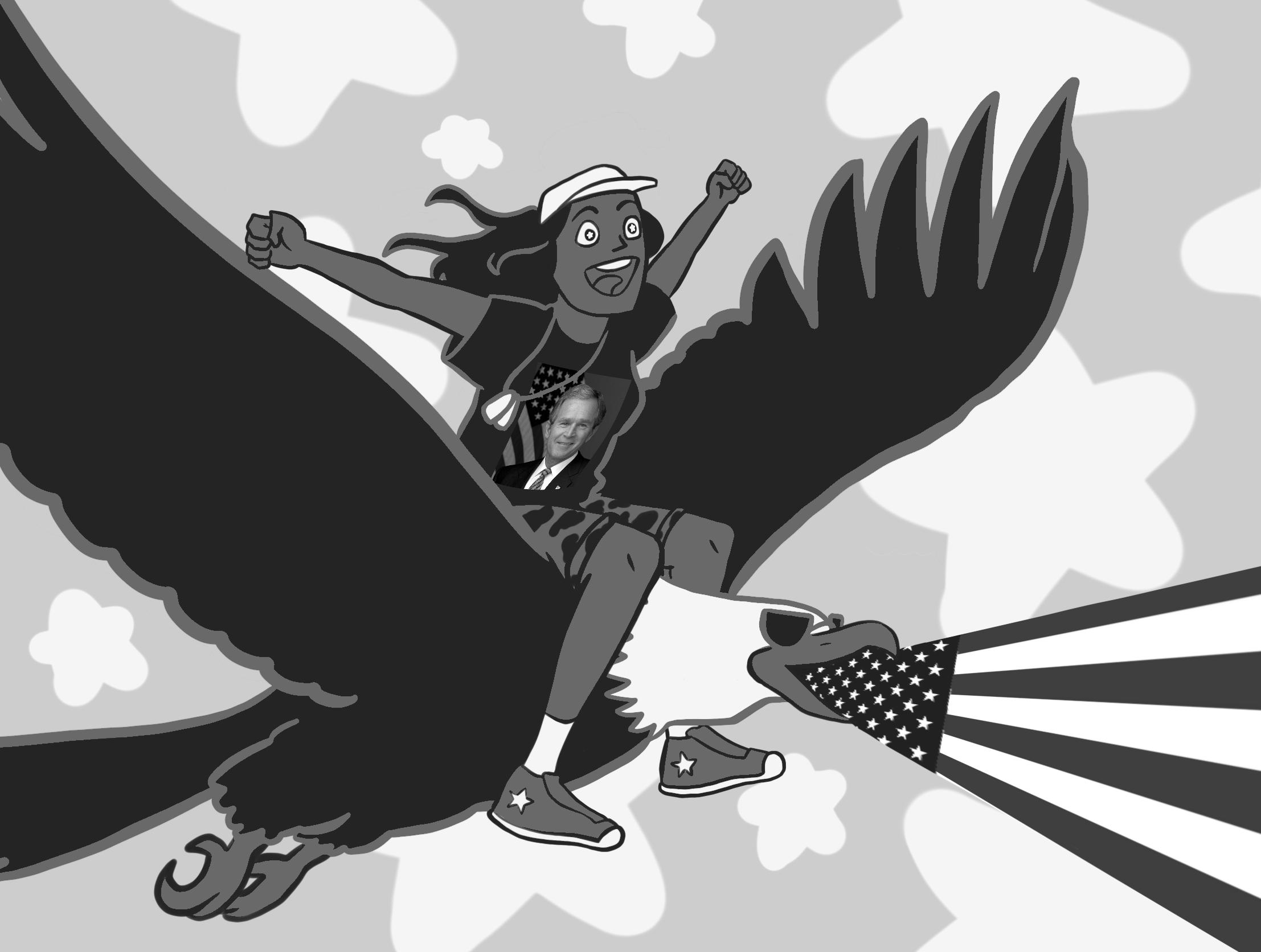
a fashion repertoire on my home campus, Claremont McKenna College, where passers-by know me and my true social and political stances. Being a foreigner in the United States helps too because my America-boo outfits more clearly stem from a fascination with an unfamiliar culture, not an endorsement of a political candidate or ideology.
While I’m all for taking risks and making people whip their heads around in shock at your outfit, I will give this disclaimer: You will get judged and be stared at.
Yes, it’s a shame that your values and identity can be challenged by anyone who has never seen or spoken to you before simply based on the shirt that you are wearing, but you cannot control people’s biases. So don’t think twice about them.
To me, fashion is a lot about intention: the intention behind why you chose to pair two pieces together, the intention behind why you chose to draw attention to a specific item on your body and the intention of what you want your clothing to reflect about you.
When I wear my America-boo fits, my genuine intention is to make people laugh and maybe even challenge people a little bit — challenge them to have a conversation with me and get to know me, instead of deriving my views, values and intentions from my clothing.
As long as you are not wearing anything hateful or offensive, then there’s no harm in being a little provocative. And an America-core outfit is not hurting anyone — we are in America, after all.
Fashion is an art form and without controversialness and innovation, it would be boring. Just because art is supposed to challenge viewers’ preconceptions doesn’t mean that the artist actually holds the view that their art presents. Think about this concept in terms of literature and visual art.
To those who have never considered the possibility of fashion being ironic and purposefully provocative: Don’t be so quick to judge others.
If you see an interesting or provocative outfit, approach its stylist and open up the conversation.
If somebody had asked me about my America-core looks, then I probably wouldn’t feel the need to write this article.
I bet our Claremont fashionistas have some groundbreaking motivations behind their daily looks that they are dying to share with you.
MArch 22, 2024 PAGE 5 Arts & Culture
LIFE
QUINN
NAchTrIEB • ThE STUDENT
TANIA AZHANG
SAShA MATThEWS • ThE STUDENT LIFE
Elizaveta (Lisa) Gorelik CM ’25 is from Moscow, Russia. Her spring break in Utah has
her much-needed America-core fashion inspiration.
given
AMErIcAN IN PArIS
Columnist Tania Azhang PZ ’25 is currently studying abroad in Paris. She often wonders if Sartre was right about hell and other people.
‘The
Room’ is high art (and I’m not kidding)
A few years ago, when I was just a baby Arts & Culture columnist and not the beloved, widely respected mind-shaper I am today, I wrote a little article about a film called “Hackers” where I said I liked the movie even though it was bad.
The article is fine (the movie is much better), but in the time since writing it my thoughts about the subject have changed — and since I was lucky enough to attend a screening of “The Room” earlier this month, the concept of a “so bad it’s good” movie has been on my mind a lot.
So, I am here now to right my wrongs: Not only is “Hackers” not a bad movie, but the concept of a movie being “so bad it’s good” is flawed at its core. I’m going to prove it and “The Room” is going to help me.
“The Room” is a low-budget 2003 drama film written and directed by Tommy Wiseau and widely considered to be one of the worst films ever made. Everybody knows that. It’s first-grade stuff. “Crash” (1996) is better than “Crash” (2004), “North by Northwest” is the fifth best Hitchcock movie, “The Room” is the worst movie ever made: film’s fundamental truths. The movie’s been talked about enough that it feels utterly redundant to describe “The Room” and all its faults, so I’m not going to. The numerous reasons why “The Room” sucks have been reiterated enough that the prospect of being the umpteenth-thousandth internet nobody to say “The acting and writing and editing are bad” makes me want to quit writing altogether.
Nonetheless, I make my pittance hawking milk-warm contrarianism for a student newspaper, so here’s the part where I blow everyone’s minds by saying that “The Room” is actually good. If I am not scorching and topical, then I am nothing.
The thing is, “The Room” is good, though. It’s really good and
it’s really good for really special reasons.
It’s incredibly funny, of course, and funny in a way that most films aren’t. “The Room” is, at its nucleus, a melodrama about a successful, widely beloved and devilishly handsome banker (played by Wiseau) whose cruel fiancée decides to cheat on him and frame him for domestic abuse (for no reason other than the fact that she is a fickle, hateful woman).
It’s a patently absurd, laughably misogynistic male victimhood fantasy that would be repulsive if it weren’t so hard to take seriously at face value.
That’s part of the brilliance. It desperately wants to be a serious portrait of a tragically virtuous all-American guy brought low by malicious feminine wiles and yet, the final film paints this mindset as something that can only be laughed at.
A lead performance dripping with awkward, ugly sincerity. A lumbering B-plot fistfight against a sinister drug dealer. Five sex scenes set to full-length R&B tracks. Most films have
the judgment to omit these peculiarities, but the value of “The Room” — both as a piece of entertainment and as a work of art — hinges on them. It’s a misshapen reflection of the film it wants to be: an unintentional parody of its central ideas and a scathing one at that. It lays its strange, flawed worldview completely out in the open and then utterly and entirely neuters it. That’s special. That’s fascinating. I can’t, in good conscience, call a work of art that interesting “bad.”
It’s a legitimate triumph in naivety and hubris, a funny, captivating, endlessly dissectable piece of media that could never be replicated by people who knew what they were doing. That is magnificent. That is inspirational. That is a type of high art.
All discourse around the goodness (and badness) of “The Room” kind of revolves around the assumption that art is only good when it’s good on purpose, when it lays out its goals and achieves them and when the goals it sets out to achieve are
good goals.
We like to pretend that the rubrics we create for art are steeped in some kind of objectivity. It’s not true, but we like to think it is. Movies are good when they look professional, when their acting is believable and when the editing is seamless.
“These are the qualifiers,” we tell ourselves. “These separate good films from bad ones.”
This is the wobbly half-truth that “The Room” (and movies like it) topples over. These films work, not because they succeed within some pseudo-authoritative, weakly-defined metrics, but because they break apart our systems of defining quality all together and they do so without even trying. By most criteria, the pieces of “The Room” shouldn’t function and yet, the final work is deeply enjoyable and original and interesting.
Would “The Room” be a better movie if the acting was stronger? If the story was more traditional? If the shots were never out of focus? I certainly don’t think so. There are a mil -

lion movies with decent acting, stories and camerawork and most of them aren’t a fraction as fun or memorable or thought-provoking as “The Room.”
A sliding scale from “bad” to “good” doesn’t accommodate “The Room” very well. It’s not 90 percent bad and 10 percent good, nor is it the inverse. It doesn’t fit on any part of that spectrum. It just highlights its cracks. That is worth examining. That is valuable.
I’m not saying that all films are created equal. I think there are good movies and bad movies, and I have my own strong beliefs about many, many films. But “goodness” and “badness” can be limiting concepts, especially when we try to come up with “objective” (blegh) metrics for them.
Subjectivity is uncomfortable. We want our beliefs to be based in things that are inarguable and quantifiable. We want to separate our own beliefs and opinions and histories from the art we feel strongly about. We say silly things like “Villeneuve’s ‘Dune’ is objectively better than Lynch’s,” or worse, “The Room sucks, but I like it anyway.” These grasps for infallibility are a fool’s errand. Even if some ineffable measure of artistic goodness could be metrically outlined (a nauseating hypothetical), what good could it possibly fulfill if it prevented us from getting to explore the strange Mormon overtones of “Twilight” or the delightfully off-base board-room trend-jacking of “Howard the Duck?” That is a world I wouldn’t want to live in. That’s basically Hell. God bless “Hackers,” God bless “Twilight,” God bless “Howard the Duck” and God bless “The Room.”
Gerrit Punt PO ’24 is a pretentious contrarian dipshit. He believes in fake things like “subjectivity” and he only likes movies that are really, really bad. He also once got a really, really awkward photograph with Greg Sestero.
Going on Foot(hill): Navigating public transit
Let’s face it: Claremont, California isn’t necessarily the mecca of public transit. We’re located smack dab in the middle of the Pomona Valley and 35 miles from Los Angeles. The Inland Empire is a beautiful place in and of its own, but it can sometimes feel like we’re in the middle of a quiet, rural desert.
As first-year, my friends and I tend to grouse about not having cars. Over spring break, we took advantage of Zipcar — a vehicle reservation service that bills you by the hour or day — for trips to Huntington Beach and San Diego. Because Zipcar — unlike services like Uber or Lyft — enables you to drive and thus choose, alter and add your own destinations, it’s perfect for groups going on overnight trips or traveling long distances.
But what if you can’t drive?
There’s so much to see and do beyond Claremont, but not everyone knows that there are alternatives to expensive Ubers or dreaming about having your own car. I’m breaking down a few public transit options to keep in mind for your next trip.
Foothill Transit bus system (free): Perfect for traveling short distances around Claremont and to neighboring cities such as Montclair and Pomona, Foothill Transit buses will bring you to essential locations such as Target or Trader Joe’s. They’re also rarely crowded, quite clean and surprisingly comfortable. Just don’t forget to signal ahead for your stop by pressing the yellow touch strip along the wall.
Buses come every half an hour. They’re not perfectly reliable and tend to run five to 15 minutes late, but all trips are completely free with a Foothill Transit Class Pass, which you can get at Connection in Honnold Mudd Library. I take Line 188 (West: Azusa) each week to my hot yoga class.
I’d recommend stopping by the adjacent strip mall for a coffee from Sanctuary Coffee or a fresh bouquet of flowers from Sprouts Farmers Market.
Metrolink rail system (free): If you’re looking to travel westward into LA, taking the San Bernardino line from the Claremont Station will get you as far as Union Station, which is about an hour long trip. From Union Station, you’ll find yourself in the heart of downtown LA. You can either navigate by bus (Little Tokyo and Chinatown are close by) or transfer to other lines.
The Metrolink train is generally predictable (here’s the schedule for lines and stations) and all rides are free under the Student Adventure Pass (you need to verify with student ID through the app), which was just extended through June.
If you’re going to LA on a weekend, the train tends to be crowded and it can be hard to find a seat. However, it’s pretty clean and there are rarely delays.
Amtrak Thruway connecting services ($5 one way):
I stumbled across the Amtrak connecting bus system before visiting friends at Caltech in Pasadena. Last semester, I spent a frustrating amount of money Ubering to and from Pasadena. This time, in my desperation to find a method of transportation that wouldn’t break the bank, I came across this handy bus route.
Although Claremont itself doesn’t have an Amtrak station, connecting buses stop here on the way to cities such as Ontario and La Crescenta. I took Route 19, which connects San Bernardino and Bakersfield. I don’t know why you’d want to go to Bakersfield, but this bus ride is extremely cost-effective, rounding out at only $10 round trip. Route 19 leaves from Claremont Station twice every day.
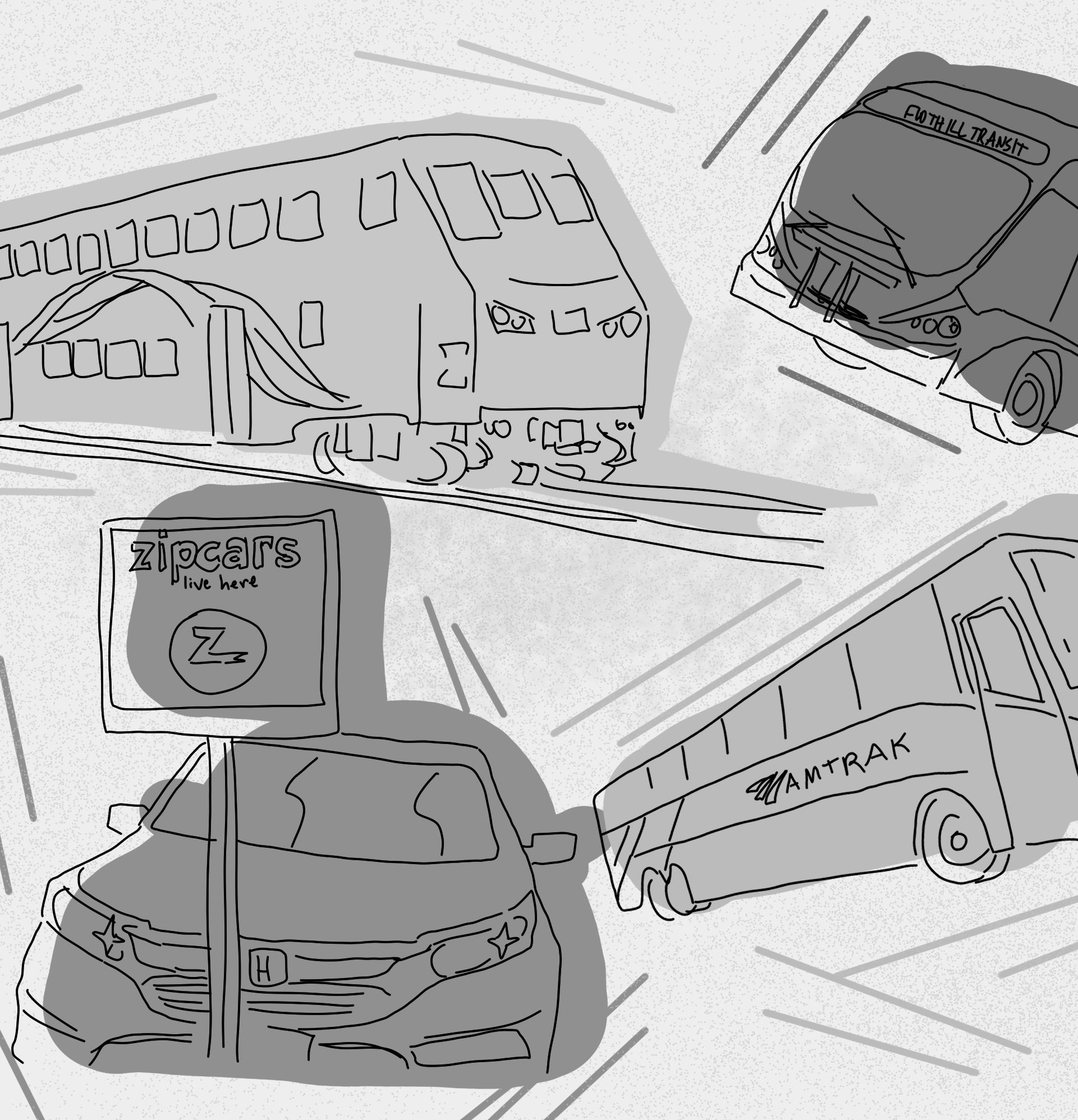
Along the way, the bus stops in downtown Pasadena and Riverside. I tend to get pretty anxious about navigating unfamiliar public transit alone, but I felt very safe traveling on my own. The bus wasn’t super crowded, the seats were comfortable and the transit time was equal to an Uber ride. I’m not here to simply wax
poetic about SoCal public transit. As you can probably guess, the above options aren’t perfectly reliable and won’t get you everywhere. However, they’re incredibly useful for those of us who don’t have a car and need to get around, whether we’re picking up essentials from Target or spending a day in LA. Next time you’re planning a trip off-campus, try looking beyond rideshare apps and embrace the possibility of public transit. Despite living in one of the most urban sprawl-ish places of all, there are many ways to get around.
Michelle Zhang PO ’27 is from the Bay Area. She’s a proud lefty and considers people-watching a hobby.
PAGE 6 MArch 22, 2024 Arts & Culture
LIFE
LUcIA
MArQUEZ-UPPMAN • ThE STUDENT
MICHELLE ZHANG
NAchTrIEB • ThE STUDENT LIFE
GERRIT PUNT QUINN
FrAME rATING LET’S GO LOcAL EMMA CONSTABLE, Creative Director JAKE CHANG, Production Editor MADDIE SHIMKUS, A&C Designer AIDAN MA, Opinions Designer NIA CARROLL, Sports Designer AARON MATSUOKA, Copy Chief AJ JOO, Copy Chief ANDREW YUAN, Photo Editor ESHA CHAMPSI, Photo Editor QUINN NACHTRIEB, Graphics Editor ANNABELLE INK, News Editor JUNE HSU, News Editor COURTNEY CHEN, News Associate MAYA ZHAN, Arts & Culture Editor PETER DIEN, Arts & Culture Editor ANURADHA KRISHNAN, Arts & Culture Associate JADA SHAVERS, Opinions Editor ADAM AKINS, Sports Editor CHARLOTTE RENNER, Sports Editor MARIKA AOKI, DEI Editor RENEE TIAN, DEI Editor HANNAH WEAVER, Multimedia Editor ABBIE BOBECK, Multimedia Editor SARA CAWLEY, Business Manager THE STUDENT LIFE BEN LAUREN, Editor-in-Chief ELENA TOWNSEND-LERDO, Managing Editor ANSLEY WASHBURN, Managing Editor TSL’s Editorial Board consists of the editor-in-chief and two managing editors. Aside from the editorial, the views expressed in the opinions section do not necessarily reflect the views of The Student Life. Singles copies of TSL are free and may be obtained at news stands around campus. Multiple copies may be purchased for $0.47 per copy with prior approval by contacting editor@tsl.news. Newspaper theft is a crime; perpetrators may be subject to disciplinary action as well as civil and/or criminal prosecution. Editorial Board Senior Staff
It’s often in Malott Commons where I encounter one of my greatest pet peeves. Whenever I walk towards the Oasis line or browse the too-often empty utensil containers, I always come face to face with another student. Inevitably, one of us has to make way for the other.
But that face-to-face encounter is not what bothers me. Usually, it’s pretty negligible, with the run-in being something I barely notice and rarely remember.
What I really can’t stand is what follows: “Sorry.”
If I asked you to finish that sentence by specifying what you’re apologizing for, you’d probably have a hard time answering. Why are we apologizing for simply being in a twofoot proximity to each other?
While these incessant “sorries” occur throughout all the 5C campuses, the Malott encounters come to mind most prominently. Particularly, I’ve noticed that the majority of the times that I hear an unwarranted apology, it is coming from another woman or femme-presenting person.
It’s in conversation with my female friends where I hear “sorries” being thrown around for verbal slips. All too often, I catch us expressing guilt when it is not warranted.
I’m not oblivious to the criticism here. “Sorry” is just a word — why am I so opposed to it being used, albeit unnecessarily?
At its core, to apologize is to show remorse for an action that has had some kind of negative impact. Apologizing for something as simple as skimming someone’s shoulder in passing makes the event seem more significant than it is. Overusing “sorry” diminishes its importance in situations where it is truly warranted.
The use of the word “sorry” has become instinctual — it’s easy to fall into the habit of over-apologizing.
For those who know me personally, you’ve probably heard me go against the message of this article and use “sorry” when I don’t need to. Recently, I caught myself saying sorry to a bench because I bumped into it as I was walking.
But, I believe it’s a habit I’ve been socialized to adopt — and am being
Stop saying ‘sorry’
explicit about unlearning.
A 2010 study found that women apologize at higher rates than men because they consider more actions offensive, and thus in need of an apology, more often than men.
For example, a woman who has been socialized only to speak when she has the floor may consider interrupting to be disruptive. A man, on the other hand, might not interpret the interruption in the same way. He might even attribute it to the normal flow of dialogue.
Interrupting can be useful when someone is confident that their point will aid the conversation at that particular moment. Consider what
the world would look like if women interrupted at the same rate as men; instead of apologizing for accidentally taking the floor, we reclaim agency over what we have to say.
I’m not saying we need to start interrupting just for the sake of it. But if we find that who we are talking to has been rambling for ages without giving us a chance to speak, it’s worth making an effort to make our voice heard.
When we apologize, we automatically assume an unpowered position, which can be counterproductive. Incessant apologizing is people-pleasing behavior because saying sorry masks the fear of an-
other person’s disapproval. We all want to be liked, but why let go of our self-assuredness for something we don’t even truly feel bad about?
Rather than turning our smallest mistakes into wrongdoings by apologizing, try offering a more confident acknowledgment. For instance, there’s the classic substitution of “Sorry I’m late” with “Thank you for waiting.”
Dining halls are busy — Malott is certainly no exception — and I’m sure we will all find ourselves unnecessarily apologizing again soon. There is no reason to feel bad about an unneeded “sorry”; just notice it and move on. The more you start to
catch onto the unnecessary apologies, the easier it becomes to unlearn. It all comes down to re-training your natural responses through a sense of acceptance.
I understand as well as any how ingrained apologizing is, especially for women — oftentimes, we do it without even realizing it. But becoming more aware of when we unnecessarily apologize is the first step to fixing the problem and taking back our power.
Parishi Kanuga CM ’26 is from Los Angeles, California. She would like to sincerely apologize for all of her past unnecessary apologies.

The ultimate plug for the vegetarian diet
After reading the title of this piece, it may be hard to believe that I adore greasy burgers and fried chicken. I am a proud foodie with an Instagram account dedicated to pictures of the food I eat, including meat.
But while saying no to my favorite burger at Pastis while on spring break in New York last week was heart-wrenching, I am excited to announce I have officially been a vegetarian for two and a half months — and it’s permanently altered my outlook on nutrition and the American diet.
I know that two and a half months might not seem like enough time for that, but hear me out.
I have eaten meat my entire life and, up until this year, I could not envision my foodie lifestyle without it.
The Netflix documentary “You Are What You Eat” is what convinced me to pursue a vegetarian lifestyle. The documentary displays the impacts
of an omnivore diet versus a vegan diet through a study on identical twins. It also exposes the history of the standard American diet and meat consumption’s impact on the environment.
I’ll be honest, I do not have the willpower to become a vegan (thanks to cheese and ice cream), but cutting out meat felt like a reasonable way to challenge the standard American diet and provide some environmental reprieve.
To my surprise, the vegetarian diet has wildly exceeded my expectations.
The vegetarian diet offers nutrition, delicious options and environmental benefits. In a meat-centric society like the United States, my discovery of a nourishing meatless diet has also motivated me to redefine what constitutes a substantive meal.
The amount of times I have been told I will not get enough protein and nutrients without meat, though, is not only unbelievable, but unsup-
ported. The belief that the vegetarian diet is nutrient-void stems from the rigid standard of the American diet, which values high caloric intake and meat consumption. Unsurprisingly, the United States has the highest per capita meat consumption in the world with projections of an average of 219 pounds of land animal per American consumed in 2018.
Because of meat’s omnipresence in American cuisine, Americans struggle to fathom a well-rounded meal without it.
Meat is not the holy grail of nutrients and protein that American diets purport it to be. Plant-based protein sources, such as tofu, lentils, beans, quinoa and protein-rich fruits and vegetables, contradict the perception that meat is Americans’ most robust source of protein.
Many cultures outside of the United States prove that meat is not needed to constitute a well-rounded meal. One example is traditional In-
dian cuisine. Many Hindus abstain from meat consumption entirely. Instead, they incorporate paneer (a type of cheese), lentils, chickpeas and various vegetables to build their hearty delicacies.
Although the United States consumes the largest amount of meat, most of the meat that’s processed will never be consumed. Estimates suggest that 21.5 percent of American meat goes uneaten by humans. As long as meat continues to be bought, the whereabouts of meat are unimportant to the meat industry.
Consequently, billions of animals are being slaughtered only to become food waste. Animal slaughter for consumption is unsettling, but animal slaughter for food waste — combined with the greedy motives of the meat industry — is overwhelmingly destructive.
The detrimental impact of meat on the environment moves beyond just food waste, though.
Meat consumption is fueling the
livestock sector’s extreme production of greenhouse gases and the deforestation in the Amazon. With the demand for more space for cattle, cattle ranchers are eager to cut down and burn the Amazon trees to make room.
The environmental impact of meat consumption and the availability of tasty vegetarian options make switching diets a relatively easy choice.
Still, just because the vegetarian diet works for me does not mean it’s compatible with everybody’s lifestyles and dietary needs. I am not trying to force people to renounce meat but rather show that the vegetarian lifestyle can be just as satisfying as the omnivore lifestyle.
Before judging someone’s choice in diet, think about why you choose your own diet. Our diets tend to align with our values and what makes us feel best. For me, that’s tofu.
Tess McHugh PO ’25 is from Denver, Colorado. She loves Ariana Grande, New York bagels and the TV drama “Severance.”

March 22, 2024 PaGE 7 Opini O ns
PARISHI KANUGA
M a XINE LE • T h E STUDENT LIFE
TESS MCHUGH
N ach T r IEB • T h E STUDENT LIFE
QUINN
The problem with ‘problematic’
ANJALI SUVA
In a rare moment of weakness, I decided to redownload TikTok, X (formerly known as Twitter) and Instagram in the middle of midterm season. I was looking for a distraction from my looming exams and deadlines and what better escape than immersing myself in meaningless internet discourse?
I learned one valuable thing from my doom-scrolling before I (fortunately) got my life together and returned to social media sobriety: It’s okay to just dislike things.
Let me explain.
Online, it seems impossible to escape the endless stream of think pieces and hot takes on the media we consume. Books, movies, music — nothing is spared from criticism.
But while it’s undoubtedly important to remain critical of what we’re consuming, it seems we’ve lost our ability to accept people’s varying preferences. Social media has convinced us that our general dislike for something needs to have a greater moral justification.
There’s no better example of this phenomenon than BookTok, a subcommunity on TikTok that focuses on books and literature. BookTok has gained popularity over the past few years, with certain book stores featuring their own BookTok collections for customers to grab the latest viral read.

consumed at face value. They also entail the more insidious assumption that authors and creators are to be blamed for real-world harm as opposed to systemic, societal causes.
The internet has become an outlet for people to moralize their preferences — to convert their preferences into values which are then used to judge others.
If one’s preferences are not morally pure by online standards — if the media is “problematic” — then the individual consuming it is morally compromised.
On social media, taking a morally superior stance by condemning a piece of media is an easy way to garner attention and falsely affirm your opinions as fact as opposed to simply saying that a certain piece of media didn’t speak to you or didn’t click with your preferences.
To some internet readers, the answer is yes. The mere portrayal of controversial topics within
Just like anything that skyrockets to popularity online, BookTok has been the subject of considerable social media discourse. Some readers have accused it of promoting books that are essentially repackaged fanfiction tropes with cheap, easyto-produce writing. Others have slammed BookTok for promoting white authors over authors of color. A growing number of readers who are familiar with BookTok have also taken to labeling certain fiction books as problematic because they include a lot of mature content, are dark fantasy books or deal with heavier emotional themes. These are certainly taboo in the book world, but the surrounding discourse begs the question: Is reading or consuming such content inherently malicious?
books and fictional media is considered detrimental because the topics themselves are emotionally challenging, triggering or even obscene by societal standards. A notable example of such a case is that of the infamous Colleen Hoover, author of “It Ends with Us.” Upon its release, the novel — which depicts an abusive relationship — was subject to large amounts of backlash for the harm it supposedly causes young girls by romanticizing abuse. While “It Ends with Us” is surely no literary masterpiece, the argument that its contents are actively harmful for readers resembles the ridiculous moral panic around video games and horror films. These arguments rely on the premise that readers are unable to distinguish fiction from reality and that controversial themes in books, movies and television must be
I’ll be the first to admit that many of the books advertised on BookTok are trashy. But I also think that the influx of people creating controversy over harmless forms of media is unwarranted. Most of the time, the “problematic” nature of certain media only exists online among internet puritans with an inability to differentiate between real-world harms and online phenomena. Media doesn’t have to be “problematic” to be disliked. It’s okay to just dislike something on personal grounds without grand justification. So, in the event that you find yourself typing up a hot take to share with your avid internet audience, stop yourself and shoot for a simple Goodreads or Letterboxd rating instead. Or take a trip to a local park and touch some grass. Anjali Suva PO ’27 is from Orange County, California. She loves watching horror films, reading fantasy books and abusing em dashes in her articles.


PaGE 8 March 22, 2024 Opini O ns
ADAM
QUINN N ach T r IEB • T h E STUDENT LIFE
Akshay Seetharam 1 2 3 4 5 6 7 8 9 10 11 12 13 14 15 16 17 18 19 20 21 22 23 24 25 26 27 28 29 30 31 32 33 34 35 36 37 38 39 40 41 42 43 44 45 46 47 48 49 50 51 52 53 54 55 56 57 58 59 60 61 62 63 64 65 66 67 68 69 70 71 Jacob vases pressure slangily "Kritik politischen 29 Ironically, Ronald Reagan led one 30 Utterance in a namesake game 31 Plant pore 35 Viscount's superior 36 Indigenous people of the Great Basin 38 Valid 52 With 13D, potential recourse from 1A and 71A 53 Vietnamese city whose name means "between rivers" 57 Boot from power 58 Speck of dust Akshay’s Crossword: Our Choices a KS ha Y SEET hara M • T h E STUDENT LIFE ACROSS 1. Elevated suit 6. Tripoli’s territory 11. Fist bump, with “up” 14. Buenos ___ 15. A French finish, maybe 16. Obamacare: Abbr. 17. Mickey’s girlfriend 19. To be, in Tijuana 20. “Hey, you!” 21. Shrewd 22. Element of last week’s 23A 23. CMC speaker series 25. Firm 27. 71A’s plea to 1A in 2020 32. ___ nutshell 33. Boardwalk’s is $50 to start 34. A French finish, maybe 37. Pen tips 39. Its “sayers” see the future 42. WAR or WHIP 43. Simple seat 45. Bovine blabbing 47. Modern art? 48. Meddlers in 2016 52. Oklahoma City NBA team 54. Volcanic product 55. Assistance 56. Tennis player Osaka 59. Note 63. Pasta suffix 64. They’re not a minor concern 66. Kanga’s kid 67. Elite 68. Do slightly better than 69. Racket 70. Dirección of Christopher Columbus 71. Leader from Scranton, Pennsylvania DOWN 1. Press (down) 2. Muckraker Jacob 3. Covered vases 4. Word with “image” or “health” 5. It’s about 52 torr of pressure 6. Tibetan authority 7. Sort (out) 8. Midmorning meal 9. Response to “Who, me?” 10. Did well, slangily 11. 1867 book subtitled “Kritik der politischen Ökonomie” 12. ___ the hole (hidden advantage) 13. See 52D 18. Brings up again 22. Fries-to-be 24. Norse god of war 26. NYC subway org. 27. The 49ers had one too few this year 28. “What’s ___ for me?” 29. Ironically, Ronald Reagan led one 30. Utterance in a namesake game 31. Plant pore 35. Viscount’s superior 36. Indigenous people of the Great Basin 38. Valid 40. 2000 pounds 41. Empty talk 44. Acid 46. Grave tone indicator LAST WEEK’S ANSWERS 49. Declining due to age 50. Baghdad denizens 51. Dodgers’ Shohei 52. With 13D, potential recourse from 1A and 71A 53. Vietnamese city whose name means “between rivers” 57. Boot from power 58. Speck of dust 60. TV type (yes, I know it’s repetitive) 61. German novel? 62. “30 for 30” airer 64. ___-tzu 65. Bawl Submit a photo of your completed puzzle here! Issue 12 Leaderboard Kahani Malhotra CM ‘27 1ST PLACE 2ND PLACE 3RD PLACE Henry Hammer HM ‘24 Jake Chang PO ‘26 This week’s puzzle is a reprint from Issue 13 due to distribution issues. Issue 16 Leaderboard 1ST PLACE Akshay Seetharam HM ‘27 MARCH MADNESS STAFF PICKS BEN BEN ANSLEY CHARLOTTE JADA JUNE ANNABELLE MEN’S WOMEN’S UNC UCONN UCONN ALABAMA PURDUE OREGON PURDUE IOWA IOWA IOWA VT OREGON ST. TEXAS USC
Spring baseball and walkout songs; an ode to the greatest glue
ADAM AKINS
As spring baseball starts up in the majors and the whirlwind of signings that defined this offseason screeches to a halt, the metallic clink of bats and the constant storm of country music that is Pomona-Pitzer (P-P) baseball practice has put a magical baseball tradition in the forefront of my mind: the walkout song.
For the baseball illiterate, an increasingly common cohort as America’s pastime continues to dwindle in viewership since the turn of the century, the walkout song is an artistic form of expression for athletes.
In my personal opinion, your selection of walkout songs speaks volumes about your character. For instance, Kevin Kiermaier, a center fielder who made headlines for pushing rookie of the year Randy Arozarena out of the way to grab a fly, walks out to Rick Ross’ “Hustlin,” the anthem of the All-American, Busch Light crushing, grindset guy that is rumored to roam Claremont McKenna College’s Green Beach shirtless whenever the sun is out.
Picking your song speaks volumes for how you see yourself in the game; are you a hero, like the hot new San Francisco Giants center fielder who rocked out to the Village People’s “Macho Man” and stunned in a Louis Vuitton shot featured on his Instagram, or a villain like Kevin “Outlaw” Kiermaier?
A walkout song can be used for good or evil. Expert team players and aspiring glue guys spend hours ruminating on such topics. Done correctly, the walkout song can act as a rallying point for the team, a highlight of an inning. But one
All-star,

wrong misstep or misreading of vibes can elicit cascades of groans from both benches.
For example, my batterymate in high school had an endearing obsession with Sabaton, a Nordic band that plays power metal centered around historical events like World War I. His decision to walk up to their hit song “Stormtroopers,” in my mind, imbued us with enough spirit-energy, moxy and chutzpah to help us push a scoring rally that helped us break a five-year streak of winless seasons. I had never seen anyone wield their weird dude energy in such a way — I was amazed and, frankly, jealous.
I was one of those players that didn’t necessarily have great pop in their bat, the ability to throw
QUINN
a runner out, or gamesense. But I excelled in making the dugout my dojo, leading chants, demanding everyone turn their hats inside out to form rally caps when we were on the edge of being mercy ruled and yelling “We love and respect you” at my boys when they went into the batter’s box. I now find myself filling this role with my friend’s wiffleball bouts and intramural sports. This is a passion of mine, so I think it’s important to look back and study the greats and the tools they used to rally their team around their mediocre play and manic fervor for the game. Living in Virginia for the lion’s share of my young impressionable years, I got to sit in the front row for the rise of the Washington Nationals to World
three-point leader and a peach; Josh Angle leaves a giant impact on CMS basketball history
ANSLEY WASHBURN
3,003 minutes of magic. 1,647 points for his beloved team. A mountain of SCIAC accolades thrusting him into the national spotlight. With his name enshrined among the greats, Josh Angle’s CG ’24 mark on Stag legacy is undeniable. As the final buzzer sounded on Friday, March 8, it signified not just the conclusion of a game, nor a season, but the finale of an illustrious career. While it marked the end of an era, the titanic impact Angle has had on Claremont-Mudd-Scripps (CMS) men’s basketball is sure to continue to reverberate through the halls of Roberts Pavilion.
Head coach Ken Scalmanini described Angle as “the most dedicated player” he has ever had, describing how his impact on the program transcends the scoreboard.
“I’m gonna miss him a lot,” Scalmanini said. “You’d think it’s just him making all the baskets, but it’s the day to day [energy] that he brings to the program that everybody sees. I cherish that.”
After starting this season with a 2-4 record, Angle helped turn the Stags around, ending the season 22-6 overall. After winning the SCIAC for the first time since 2018, Angle eventually led CMS across the country to their first ever appearance in the Sweet 16 of the NCAA Division III men’s basketball national championship tournament where they competed in the highest stakes game the program has ever seen.
Despite an impressive rally from a 14-point deficit with two minutes left on the clock, CMS fell just short to Nebraska Wesleyan at the Kirby Field House in Easton, Pennsylvania in a heartbreaking 74-70 loss ending both their season and their playoff run. Though this loss forced Angle to exit the collegiate court for the last time, he said he was proud of what his team accomplished this season. “After starting 2-4, I think all of us had a really good mindset change and sort of recognized that we all needed to be tougher both mentally and physically to be able to do what we wanted to do as a team,” he said. Although Angle gave credit to all 17 members of the roster, his teammate of five years, Rhett Carter CG ’24, recognized Angle’s leadership as the driving force behind this change. “He’s definitely one of those guys who leads by example,” Carter said. “You see what he does and you want to work harder and emulate what he does.”
Originally from Lake Oswego, Oregon, Angle dawned cardinal and gold for the first time five years ago in 2019. As a fawn, he appeared in 20 games for the Stags and averaged 4.5 points per game. He first put himself on the map with a 201920 season high 15 points against Sixth Street rivals Pomona-Pitzer,
but his rise to fame was quickly halted by the pandemic that took away his sophomore season.
“At the end of [my freshmen season] I felt really optimistic about moving forward at CMS”Angle said. “And then sophomore year was COVID-19 … I had that whole year off just training and living at home.”
As the NCAA re-emerged after the shutdown, Angle came back with a new fire. Now a junior, he stepped into his role as an upperclassman team leader, starting in all 24 games and more than quadrupling his average points per game, finishing with 18.5 across the season and ending four games with more than 30 points. By the time his junior season ended, Angle’s dominance was manifest and his path to Stag greatness was unquestionable.
By the time Angle reached his final year at Claremont McKenna College (CMC), his position as the Tom Brady of Stags’ basketball was written in stone. He averaged 21.5 points per game and surpassed the 1,000 milestone. After leading his team to a second place finish the SCIAC regular season with an overall record of 17-8, Angle’s never ending flow of accolades started to roll in. Scalmanini credited his improvement to what he described as his unparalleled work ethic. According to Scalmanini, Angle put in numerous hours outside of practice.
“He’s in the top three of the most improved guys I’ve ever had,” Scalmanini said. “It’s his work ethic that makes him really good and sets him apart from everybody else.”
His constantly dominant performance earned him a plethora of honors after the 2022-23 season; Angle received First-Team Academic All-American honors, a Third-Team D3hoops.com All-American selection and was named a Jostens Trophy finalist — awarded for a player’s athletic performance, academic achievements and community service.
In May of 2023, Angle graduated from CMC with a 3.93 GPA as an economics major in the Robert Day School of Economics and Finance. However, he decided his work as a Stag was not done yet.
After debating using his extra year of NCAA eligibility granted due to losing his sophomore season, Angle said that the realization that he only has a “finite time playing the sport he loves” convinced him to continue to play and he decided to pursue a master’s degree in management at Claremont Graduate University in order to get on final season with the Stags.
“When I thought about places to do it, there was of course potential intrigue of going in the transfer portal and doing all these different things, but when I really considered what that would look like, I
guy of all time
Series dominance in 2019, putting me squarely under the tutelage of one of the greatest glue guys in the history of baseball: Gerardo Parra. Parra was no all-star to say the least. He was a journeyman, bouncing around six teams over the course of a 13-year career, consistently hitting slightly below average but making rosters due to the gold glove defense of his early years. After three years of below league average play in the dreary confines of my co-sports editor, Charlotte Renner’s PZ ’27 home state of Colorado, many would have thought it was the end of an unremarkably average career.
That was until the Washington Nationals, at this point in the season hovering near the bottom, picked him up on league minimum salary for what was looking like a final hurrah. It was a signing that made no headlines — a low ranking team picking a defensive utility player. Against all expectations, Parra would soon enter with a bang and a chorus that would become synonymous with the World Series-bound Nats with his walk up song, “Baby Shark,”which he picked as a tribute to his two-yearold daughter.
Parra and his endearing good dad vibes would start a monsoon of pep for the Nationals and power his bat to a magical “How can you not be romantic about baseball?” moment. Parra, who over his career statistically shrunk in the clutch, started performing like a superhero when the team needed him most.
This storm started on May 11, 2019 when Parra notched a
grandslam to defeat the NL leading Dodgers as his first hit for the Nationals, following it with seven more homeruns, almost matching his career average full season homerun production in half a season.
No one could have expected the impact that Parra could make in those 89 games in the second half of the season. Despite hitting 10 percent below league average, every time Parra stepped up to plate, the greater DC metro area would shake with excitement. Avid fans were coming to games dressed to the nines for this mediocre player. This good dad and gritty utility baseball player came to embody the intrepid battle that the 2019 Nationals waged for a ring. For the only time in his career, Parra generated a total above one in the stat Win Probability Added, a key stat used to quantify clutch for baseball players.
After the season came to a close, Parra was essentially done with baseball, playing just a third of games in the 2021 season after opting out of the abbreviated 60-game COVID-19 season of 2020.
After that, Parra vanished into the annals of baseball history, quietly joining the Washington Nationals coaching staff at first base, continuing the legacy of his “Baby Shark” story. Despite his winding path to history, Parra will be remembered for generations to come by aspiring glue guys and paved the way for baseball freaks to pull themselves up by the bootstraps of their good vibes.
Adam Akins PZ ’27 is a first-year at Pitzer College who is excited to see Jung Hoo Lee of the Giants wear more Louis Vuitton dresses in the near future.
COACHES:
didn’t think I would find a place where I would have a better experience between knowing the coaches, having so many good friends on the team and being in Claremont,” Angle said.
Coming back to Roberts Pavilion as a graduate student, Angle’s twilight season shattered expectations.
After the season ended, Angle earned one of 10 selections to the NCAA DIII Men’s Basketball All-America first team in a vote from the National Association of Basketball Coaches. Angle becomes just the second player in CMS men’s basketball history to earn first-team All-America honors from the NABC, joining Chris Greene, who earned the distinction back in 1992. Angle was named the SCIAC Athlete of the Year and then went on to earn the Most Outstanding Player of the SCIAC Postseason Championship.
This season also cemented Angle’s place in CMS lore. Angle now sits as the most prolific three-point shooter in Stags basketball history, with 237 shots made from behind the arc, also posting the highest single-season total for made threes with 83. He is on the podium with the bronze medal for total points for the Stags.
Looking forward, Angle is hoping to continue to play the sport he loves at a professional level in international leagues.
Scalmanini said that Angle’s simultaneous role as the most talented and most adored player on the team is an unprecedented and special thing.
“The [first-years] adore him and like him,” Scalamini said. “The seniors respect him and the sophomores and juniors wish they were him. It’s unbelievable. I’ve never had it like this where the best player is so cheered by the rest of the team.”
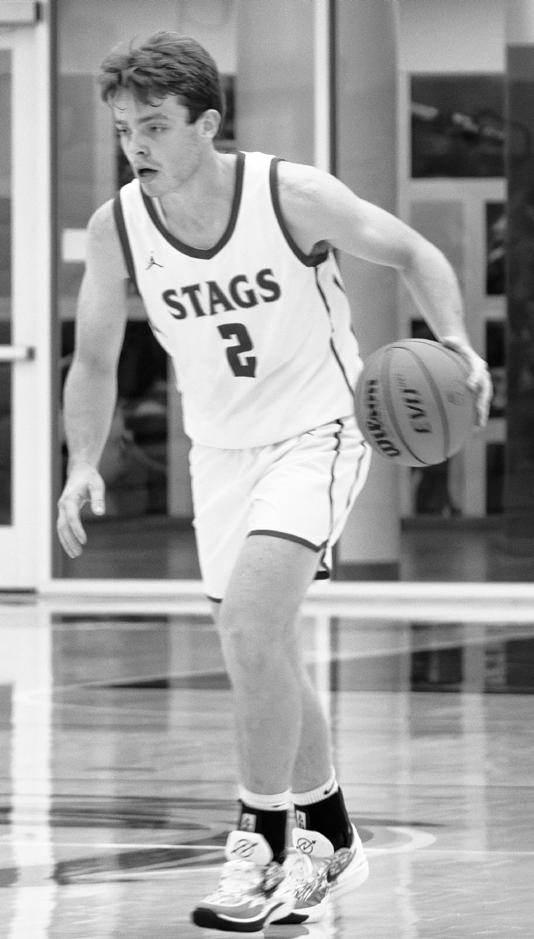
Gender gaps still prominent in NCAA, Claremont works for equality in coaching
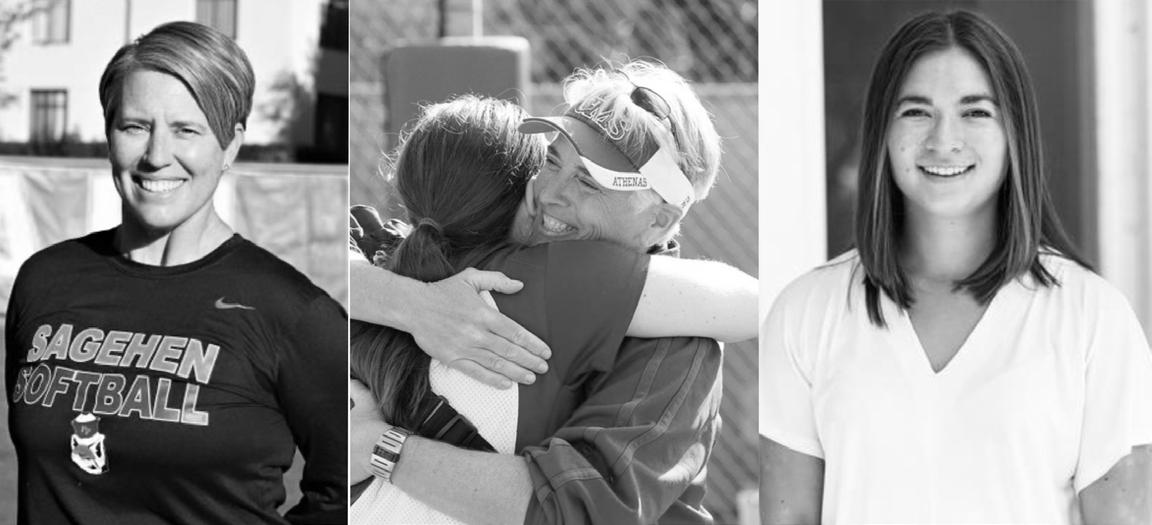
continued from page 1
According to P-P women’s basketball coach Alaina Woo, role models are important in increasing the number of women in head coaching positions. Woo, a Pomona College graduate herself, said she was encouraged to make the move to coaching by her collegiate basketball coach Jill Pace. Woo got her first assistant coaching position at Tufts College under Carla Berube, who is now head coach of Princeton’s basketball program, before returning to Claremont in 2019.
“I think it makes a big difference for student athletes, or women who want to get into coaching, to have a good role model,” Woo said. “I’ve just been really lucky to work for two really good women who not only supported me and empowered me to get into coaching when I was a student athlete [but also] mentored me when I was an assistant coach [and continue to] still really support me.” Ferguson explained how these role models can be of any gender. “My dad started fast pitch softball in the area [I grew up in] because he had two daughters,” Ferguson said. “He wanted to give women an avenue to play softball … he would think it was so cool that I’m still coaching after all this time.”
Though Ferguson and Woo noted that the 5Cs have been successful in their retention of women coaches, this is not the case across the NCAA. Organizations like WeCOACH are attempting to increase not only recruitment, but also the number of women who stay on in coaching positions for long periods of time. According to Ferguson, one of the reasons retention rates can suffer for women coaches is a lack of sufficient support
from athletic departments. “Having full time and robust support staff within programs can help retain women,” Ferguson said. “I also think having support groups or affinity groups for women within departments can be really helpful and then even within their sport programs.”
All three coaches emphasized the importance of gaining experience as assistant coaches in their path to becoming a head coach, but Woo noted the difficulty many women face in getting their first big break.
“I think a lot of times people have a very specific idea of who they want as their assistant coach,” Woo said. “Being willing to take risks on recent grads, people who have a lot of passion, women who just really want to be coaches, I think is a really important part about getting women in the industry.”
However, even if they are able to overcome the hurdle of the hiring process, an easy time is not guaranteed. Once in coaching positions, women are still met with the challenge of unrealistic expectations and responsibilities that Ferguson said are gender-exclusive.
“I think sometimes the expectation of a white, male, cisgender coach is that they just coach,” Ferguson said. “This might be a perception I have, but I feel like I take on a lot more in terms of not just the sport, but you’re connecting with people and really balancing your relationships and your results.”
There is still significant work that needs to be done to make collegiate coaching jobs more accessible for women, allowing them to see a life in their sport after graduation. “If you have a desire to play, [then] play,” Hipple said. “If you have a desire to be on the team, join the team. If you have any inclination that you think you might like coaching, try your hand at it. It’s a very fulfilling way to make a living.”
March 22, 2024 PaGE 9 Sport S
NachTrIEB • ThE STUDENT LIFE
aNDrEW YUaN • ThE STUDENT LIFE
Josh Angle says goodbye to his five year home of Roberts Pavilion.
cOUrTESY: cMS aND P-P aThLETIcS
LEFT TO RIGHT: Joanne Ferguson, Betsy Hipple, Alaina Woo.
Save 25% on Tuition!
Six-Week Session: May 20–June 28, 2024

Make

Open to All Students Enrolled in An y Accredited Institution
Open to All Students Enrolled in An y Accredited Institution
Taught by Pitzer College & Claremont Colleges Faculty • Full-Credit Courses
Taught by Pitzer College & Claremont Colleges Faculty • Full-Credit Courses
Housing Available • Financial Aid Available for Those Who Are Eligible
Housing Available • Financial Aid Available for Those Who Are Eligible
AMST 012: Intro to Race, Ethnicity, and American Cultural Studies
AMST 012: Intro to Race, Ethnicity, and American Cultural Studies
ANTH 002: Introduction to Sociocultural Anthropology
ANTH 002: Introduction to Sociocultural Anthropology
ANTH 055: Reproductive Justice
ANTH 055: Reproductive Justice
CGS 010: Introduction to Critical Global Studies
CGS 010: Introduction to Critical Global Studies
CGS 050: Power and Social Change
CGS 050: Power and Social Change
CHLT 013: Intro to Caribbean Studies
CHLT 013: Intro to Caribbean Studies
CSCI 004: Introduction to Computer Science for Non-Majors
CSCI 004: Introduction to Computer Science for Non-Majors
EA 089: California Beaches
EA 089: California Beaches
ECON 052: Principles of Microeconomics
ECON 052: Principles of Microeconomics
ENGL 047: The Human Condition: A Longform Journalism Practicum
ENGL 047: The Human Condition: A Longform Journalism Practicum
PHIL 036: Gender, Crime & Punishment
PHIL 036: Gender, Crime & Punishment
PHIL 039: Philosophies of Place
PHIL 039: Philosophies of Place
POST 030: Introduction to Comparative Politics
POST 030: Introduction to Comparative Politics
POST 040: Introduction to International Politics
POST 040: Introduction to International Politics
POST 091: Statistics and Data Analysis for Politics
POST 091: Statistics and Data Analysis for Politics
POST 135: Political Economy of Food
POST 135: Political Economy of Food
PSYC 010: Introduction to Psychology
PSYC 010: Introduction to Psychology
PSYC 101: Brain and Behavior
PSYC 101: Brain and Behavior
PSYC 103: Social Psychology
PSYC 103: Social Psychology
PSYC 194: Seminar in Social Psychology
PSYC 194: Seminar in Social Psychology
HIST 098: Palestine and Israel: A History of the Conflict
HIST 098: Palestine and Israel: A History of the Conflict
LGCS 007: Writing Systems
LGCS 007: Writing Systems
MATH 052: Introduction to Statistics
MATH 052: Introduction to Statistics
MS 056: Digital Mythologies
MS 056: Digital Mythologies
ORST 151: Participatory Action Research
ORST 151: Participatory Action Research
SECU075: History of Atheism/Freethought
SECU075: History of Atheism/Freethought
SOC 030: Deviant Sex Cults
SOC 030: Deviant Sex Cults
SOC 183: Consumer Society and Culture
SOC 183: Consumer Society and Culture
SPAN 002: Continuing Introductory Spanish
SPAN 002: Continuing Introductory Spanish
SPAN 033: Intermediate Spanish
SPAN 033: Intermediate Spanish Register
Register Now!
For more information, visit www.pitzer.edu/summer or contact: dofcore@pitzer.edu
For more information, visit www.pitzer.edu/summer or contact: dofcore@pitzer.edu
PAGE 10 MArch 22, 2024 ADVERTISEMENT
RegisterNow! 2024
more Full Credit
Courses include psychology, media studies, economics &
Courses
your summer count! Catch up or jump-s t ar t your year.
Now!
RegisterNow!

























